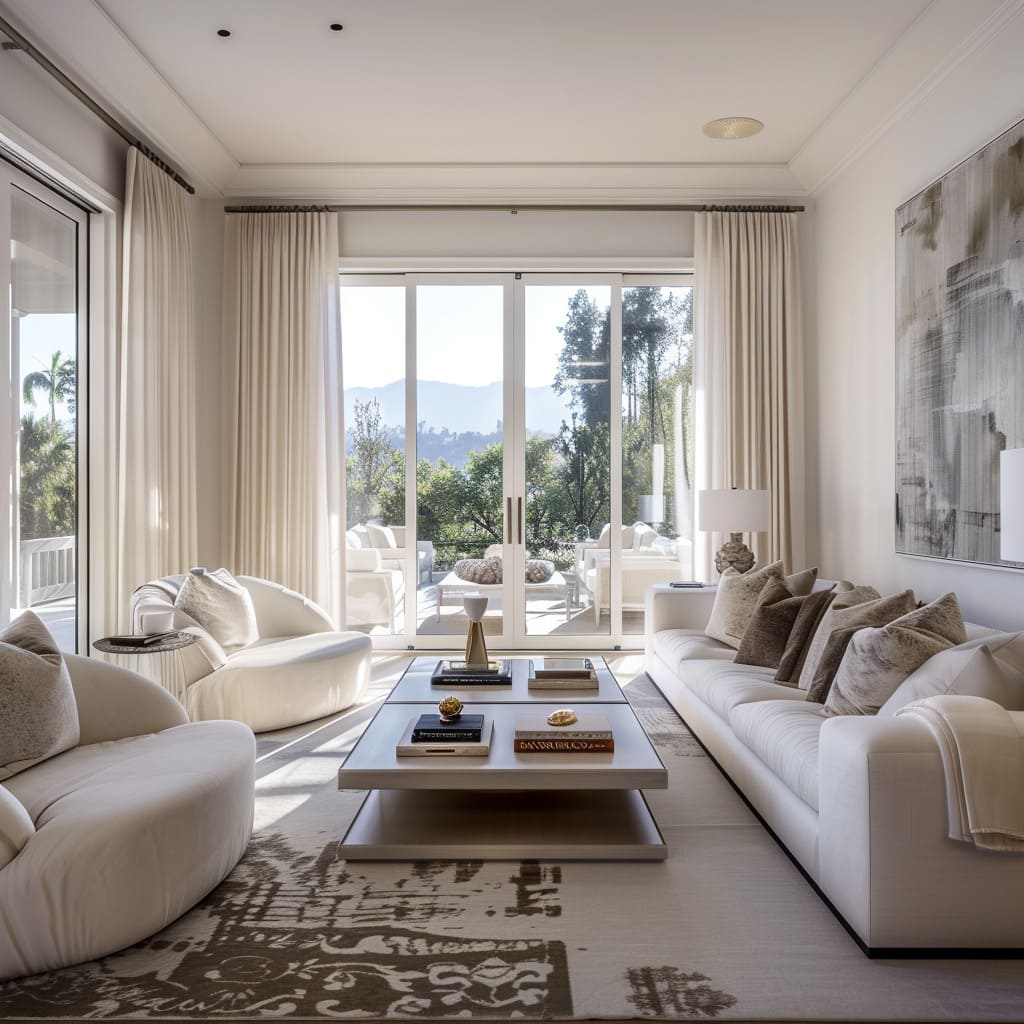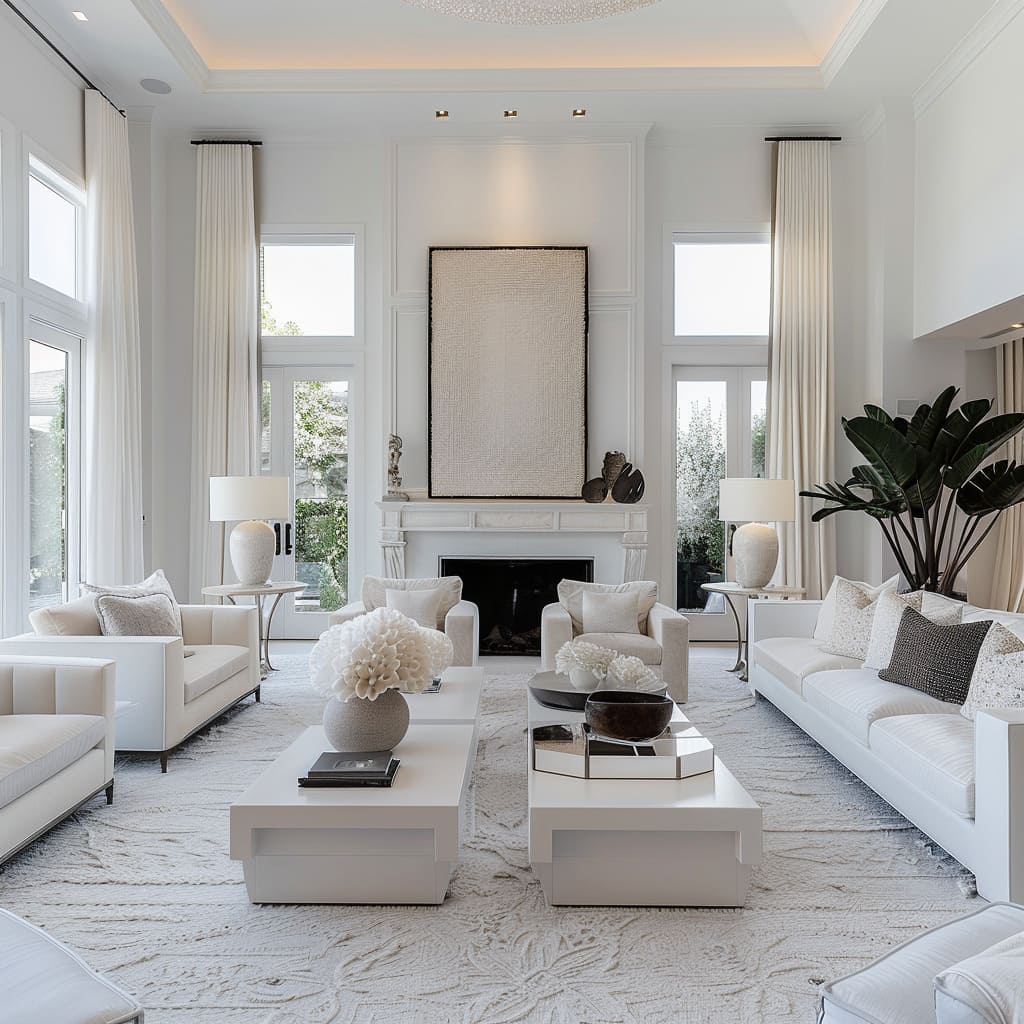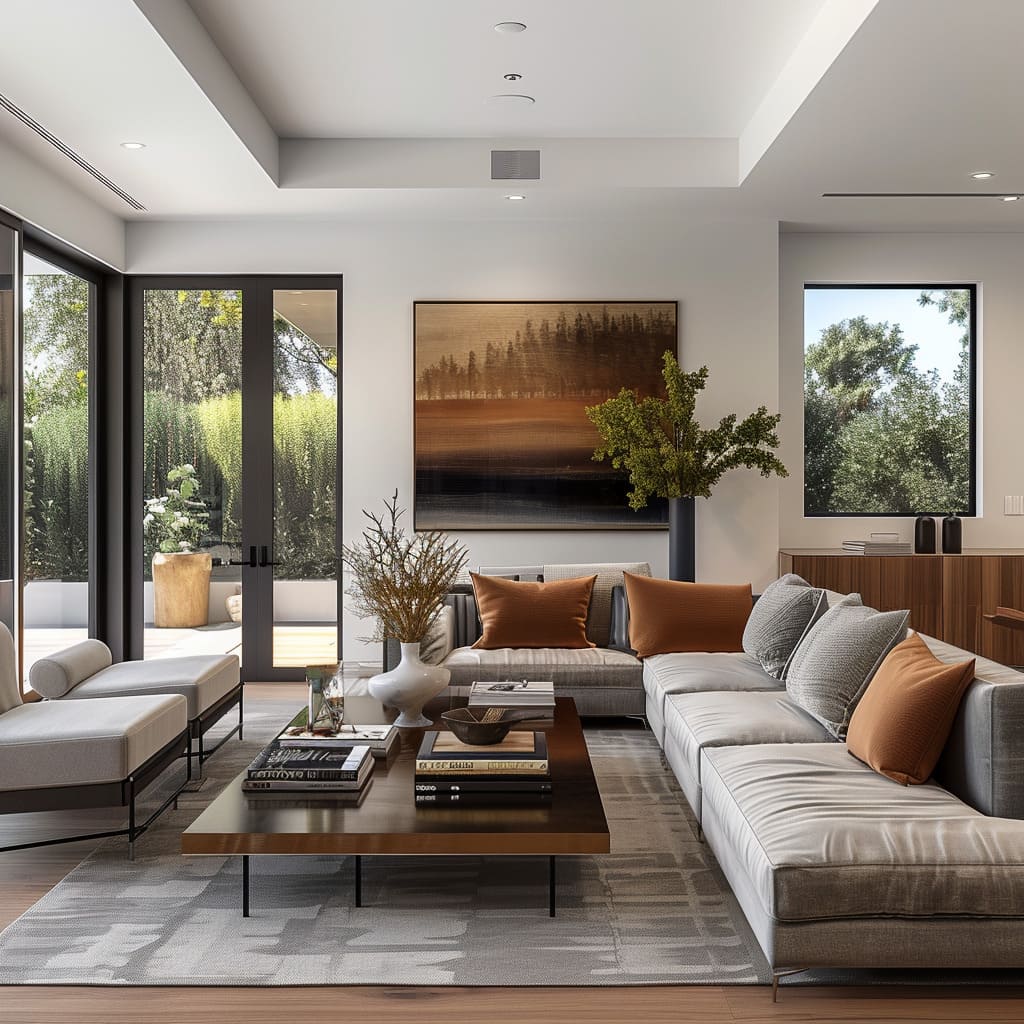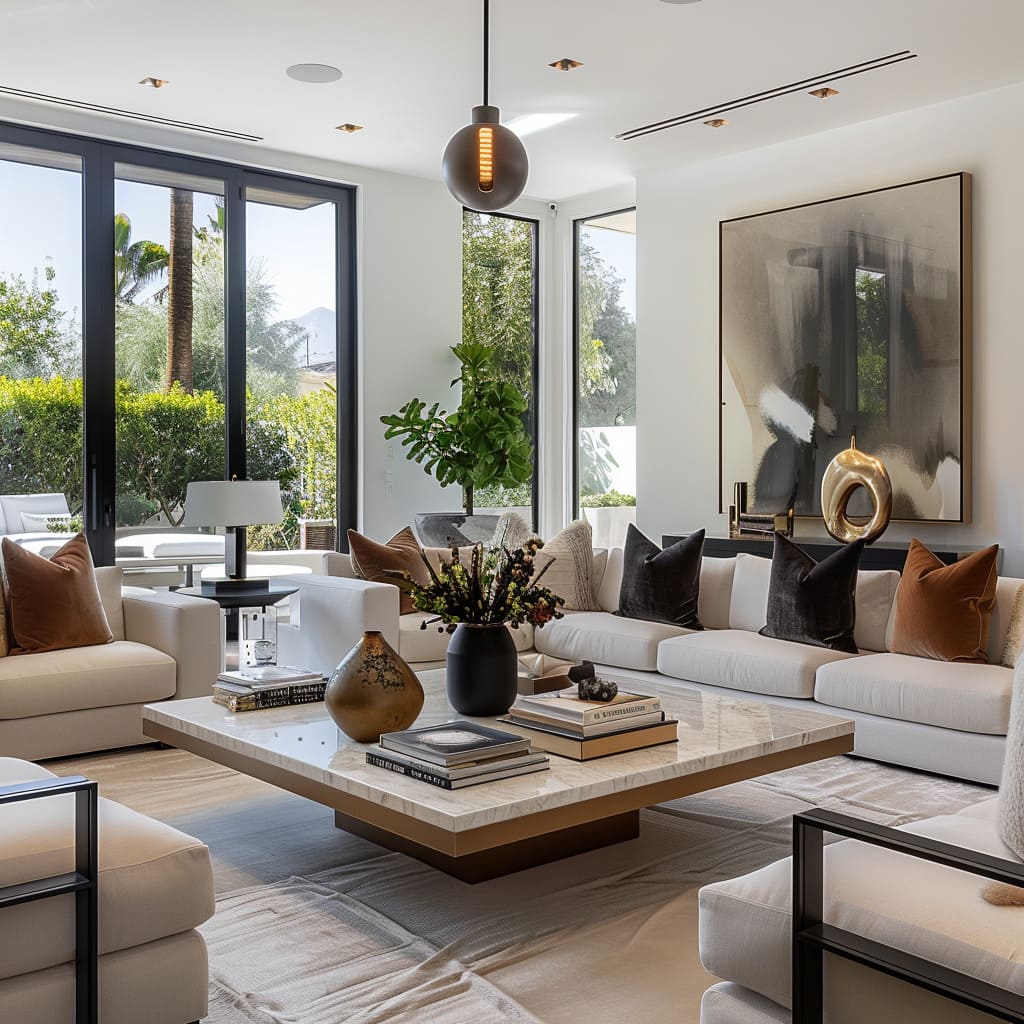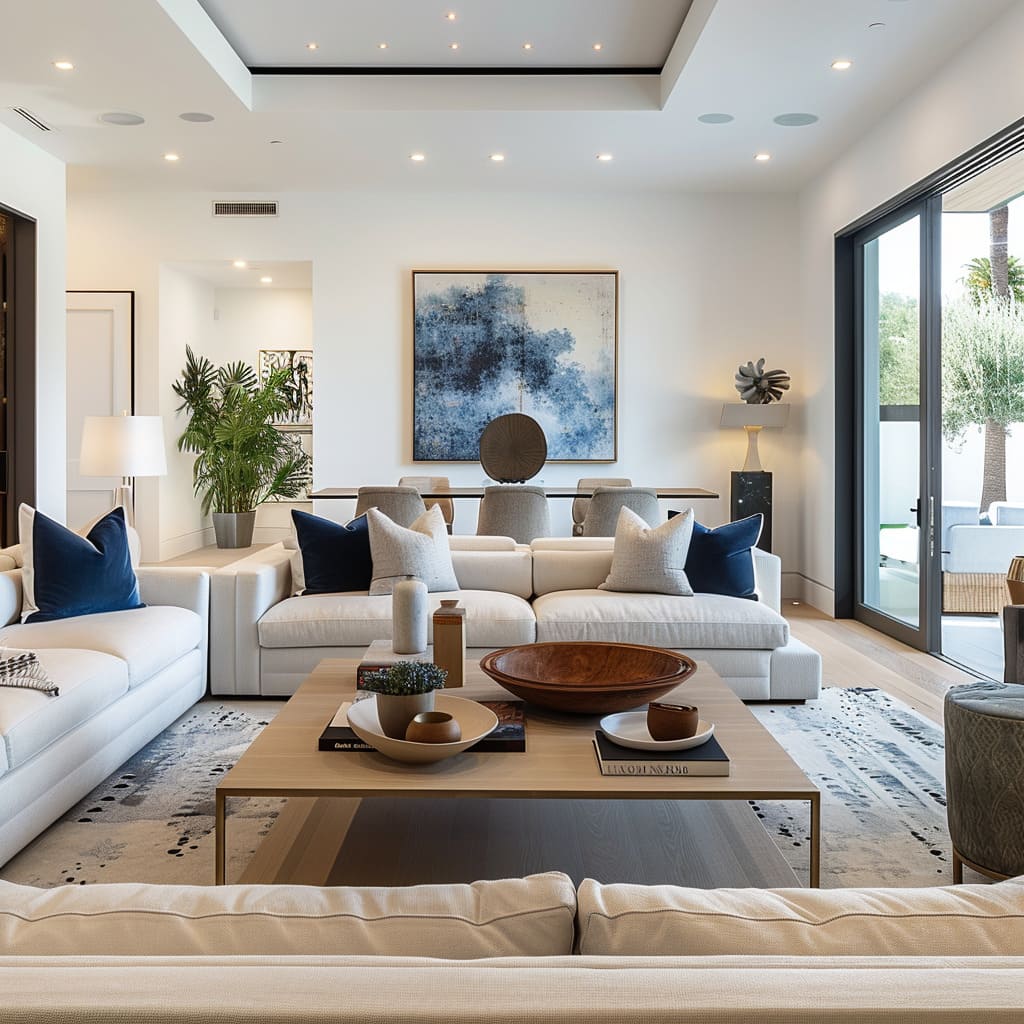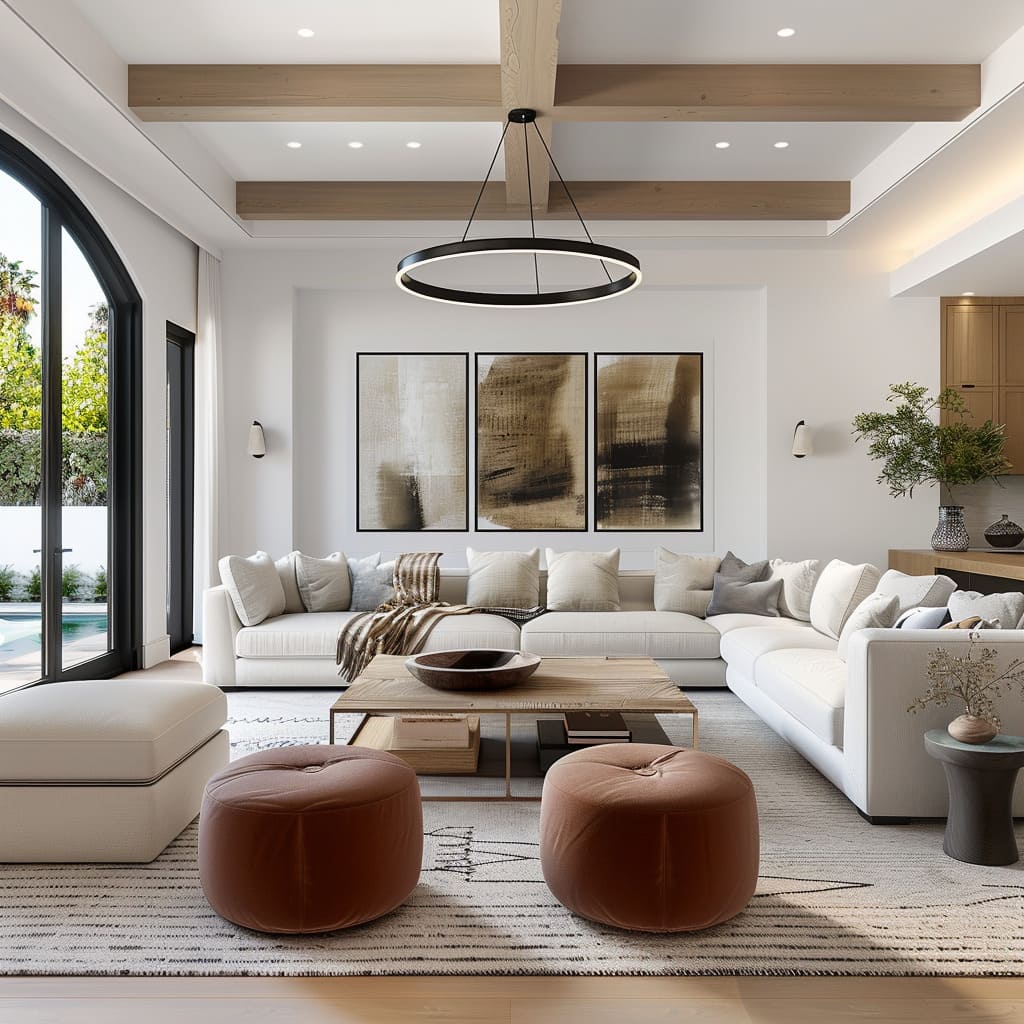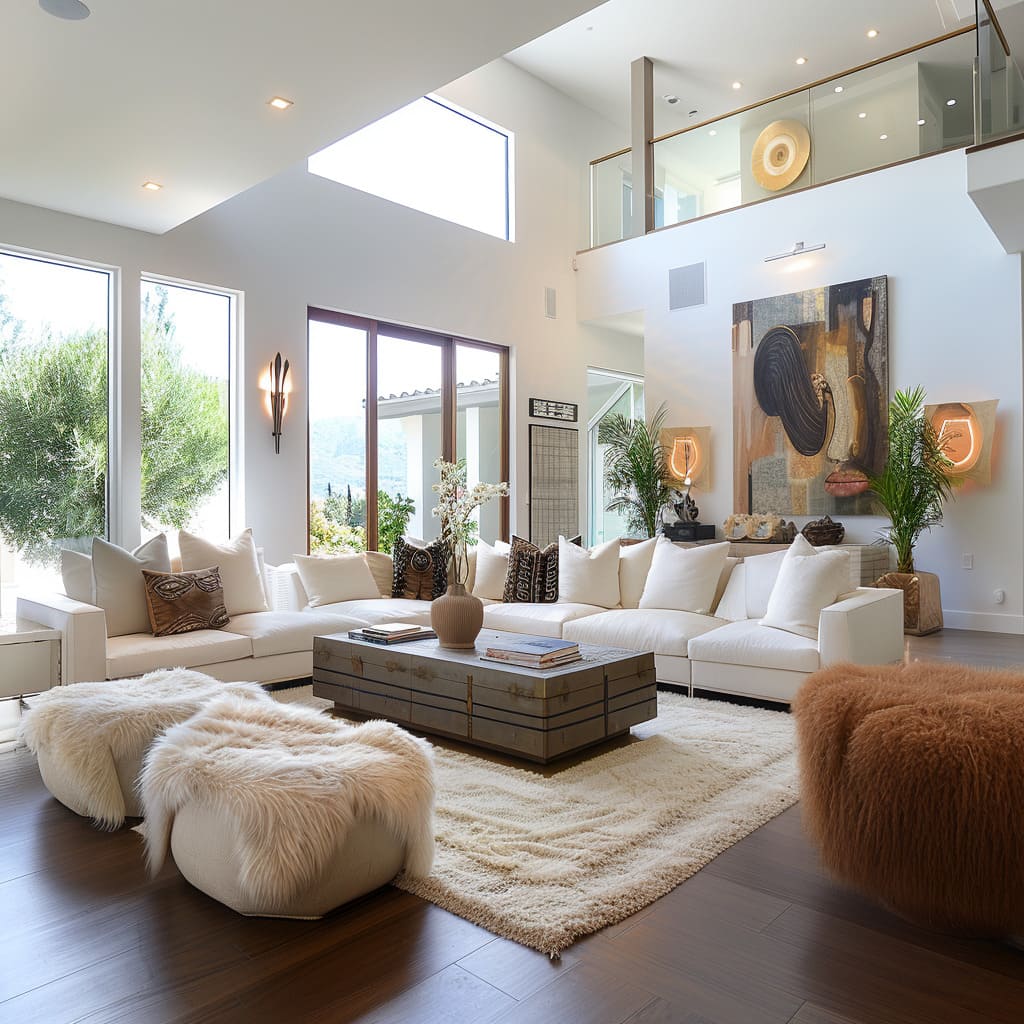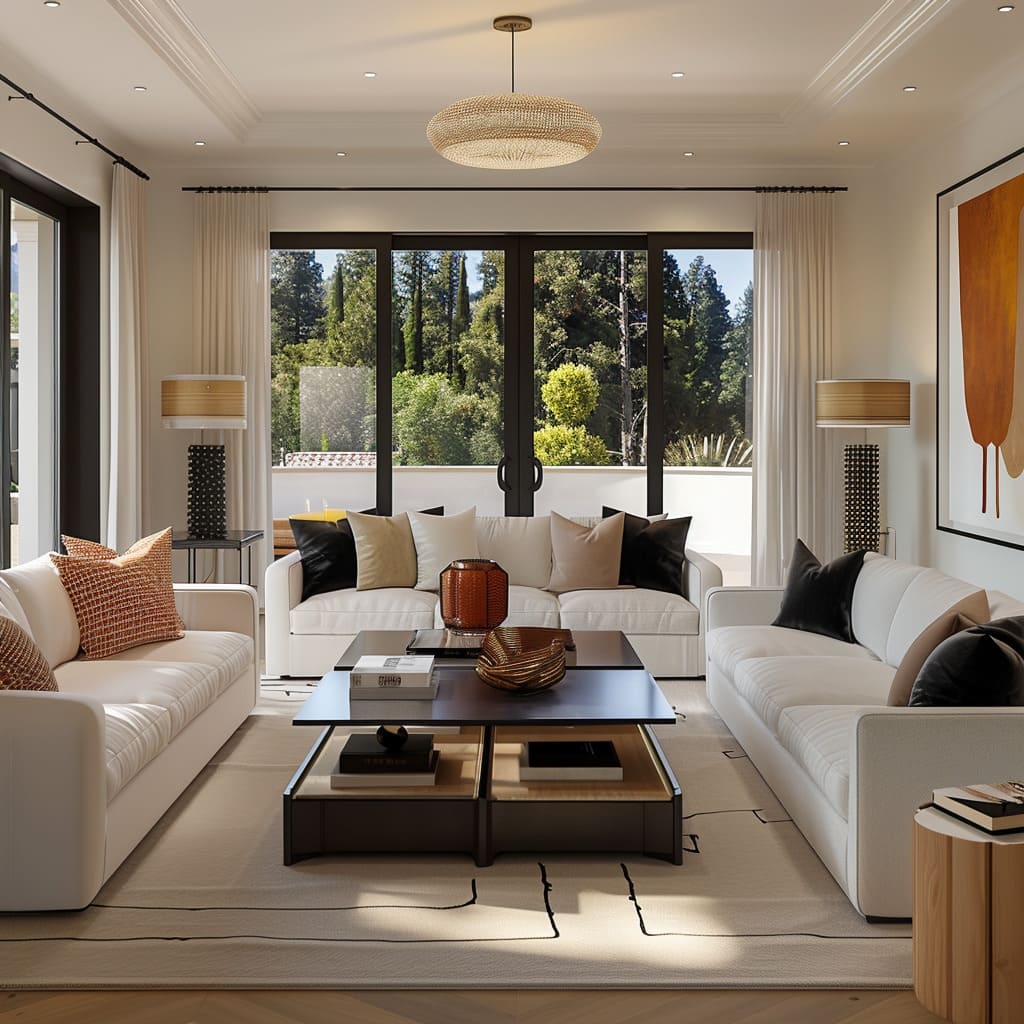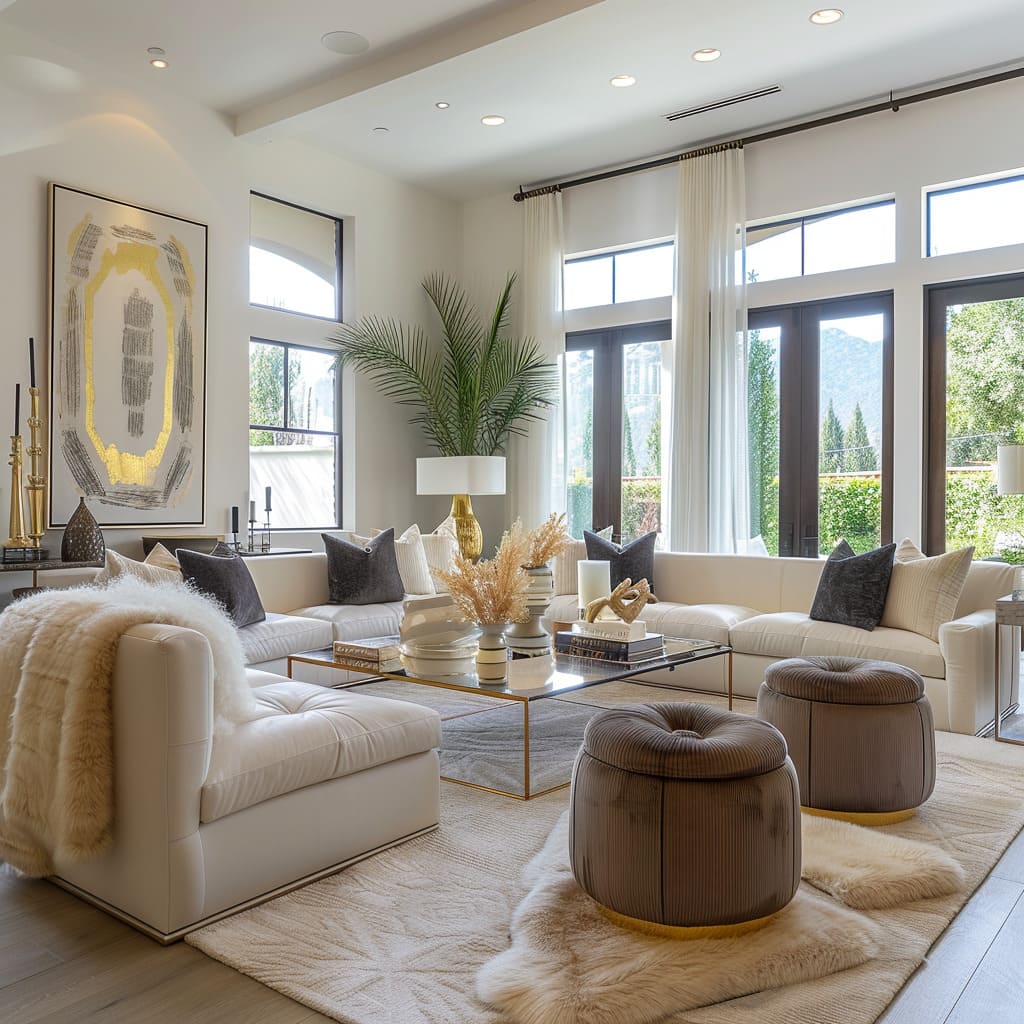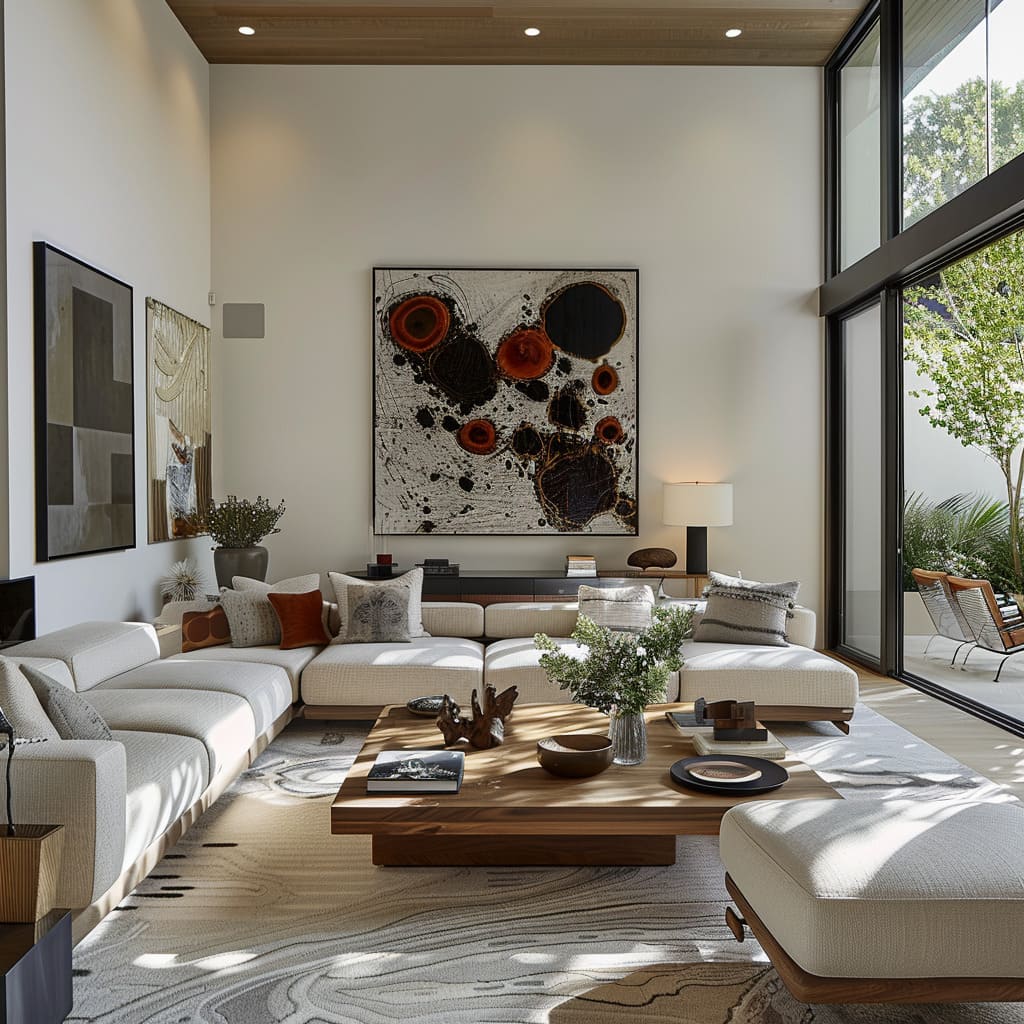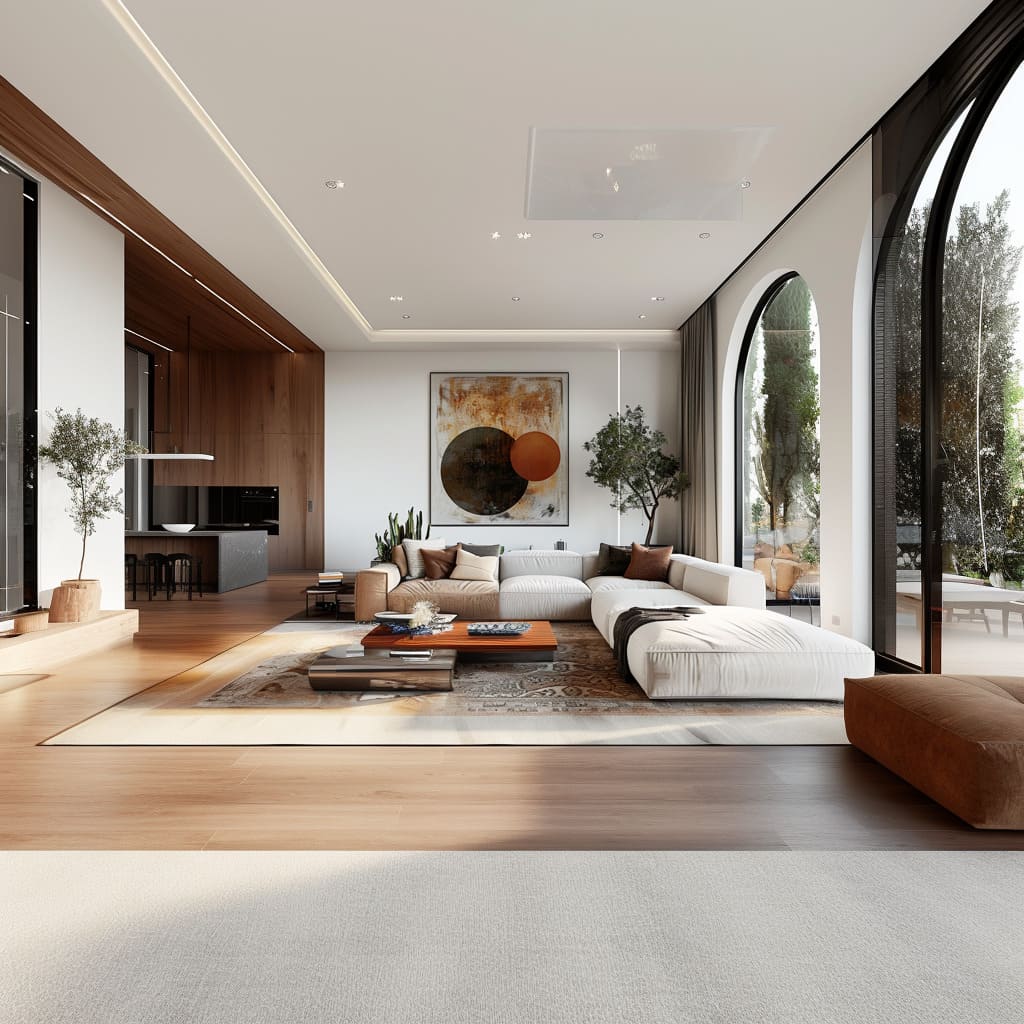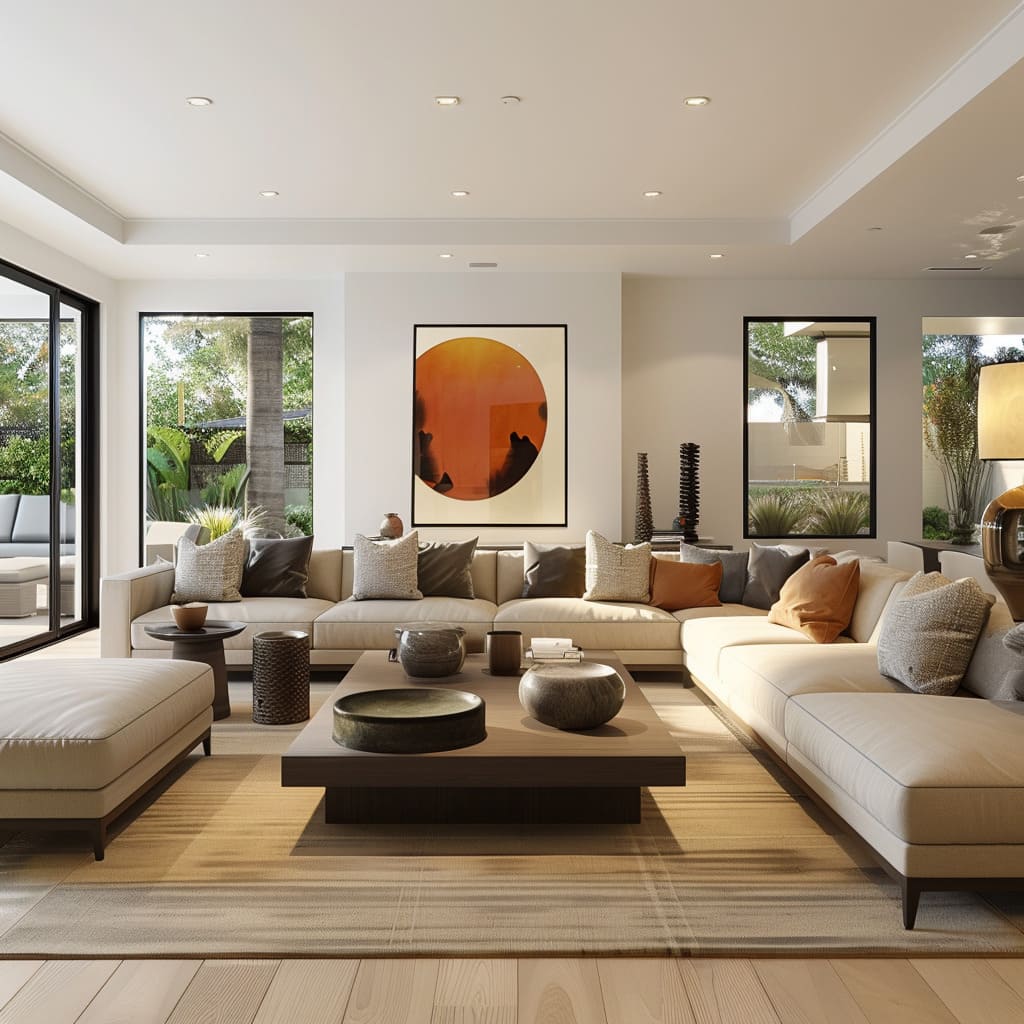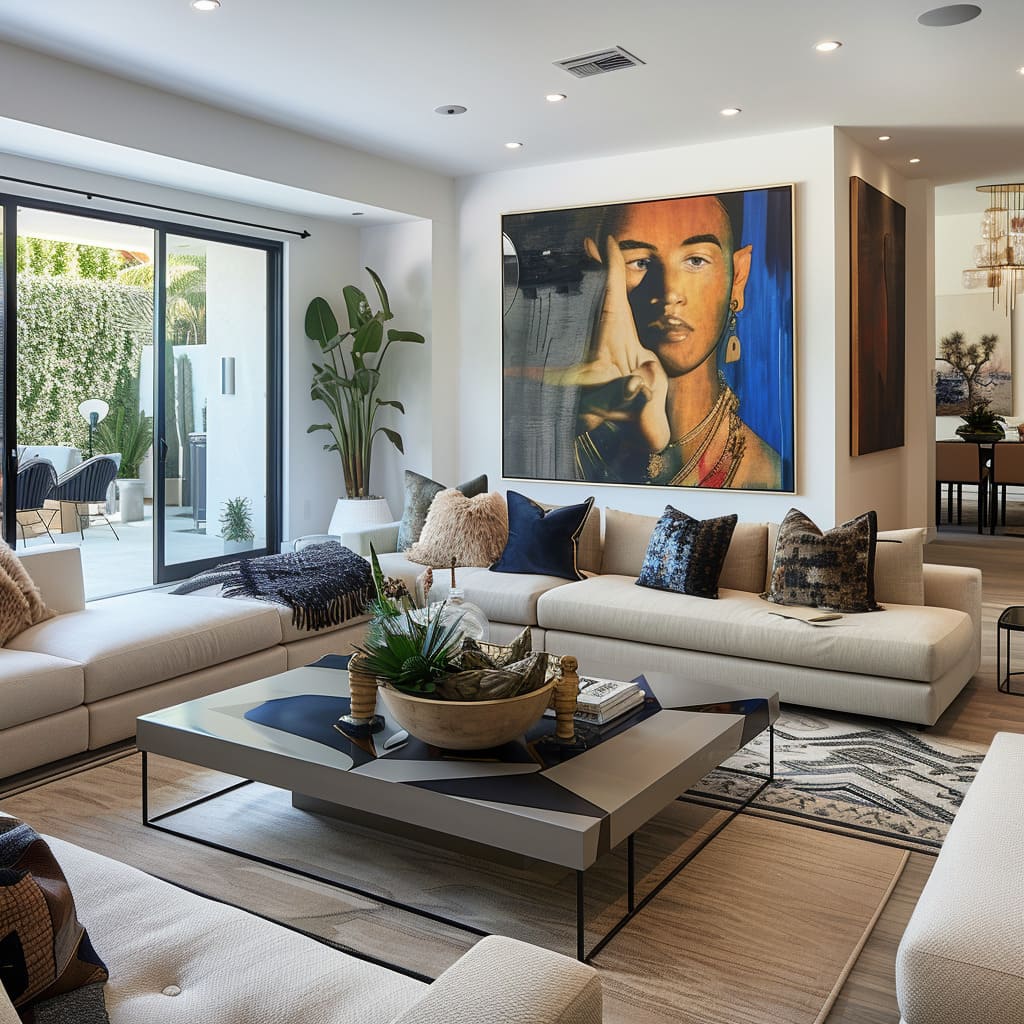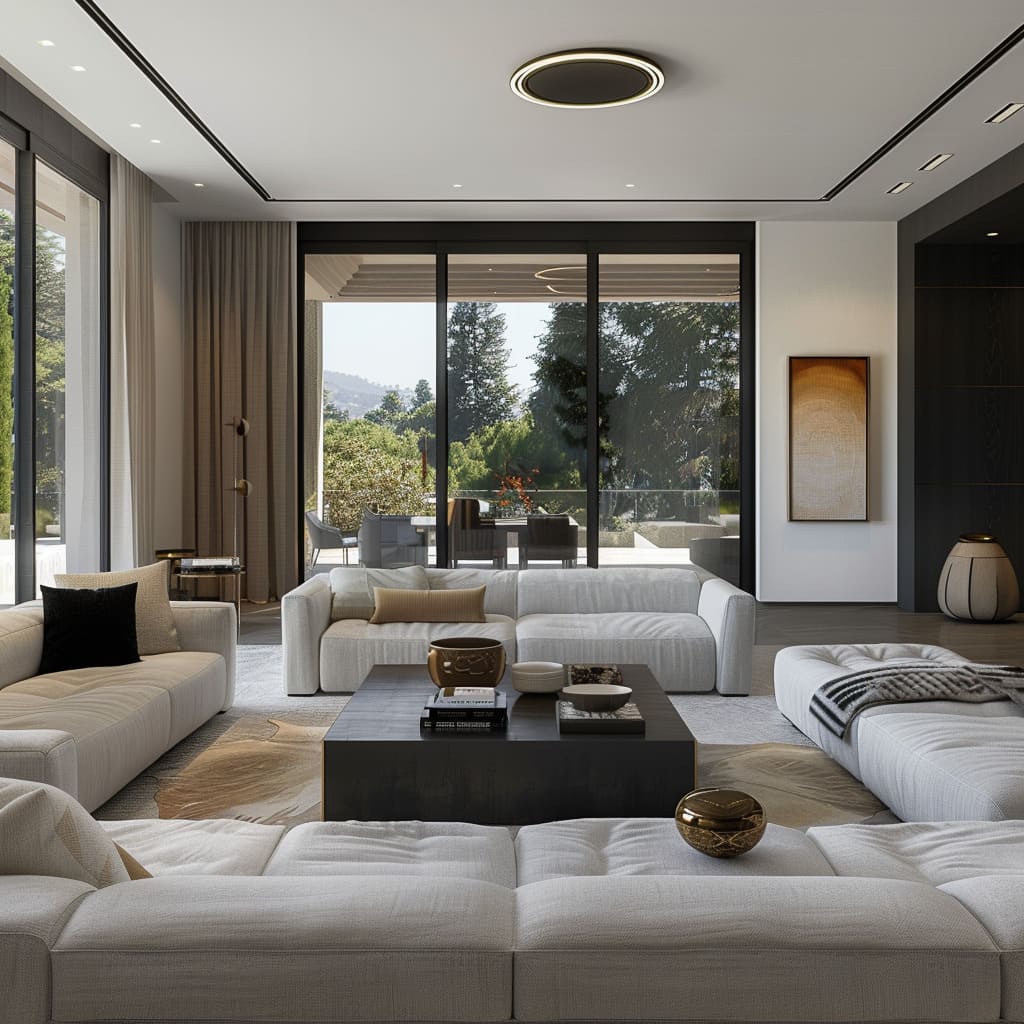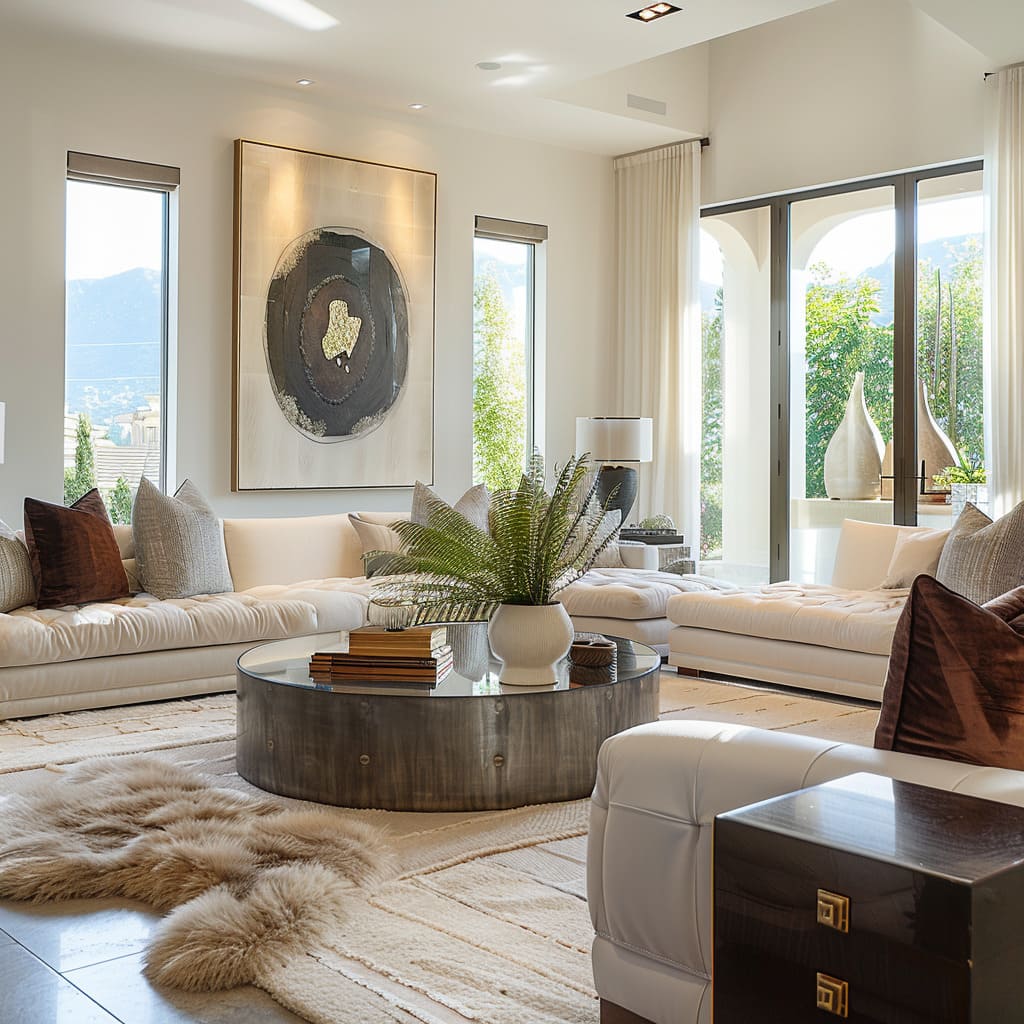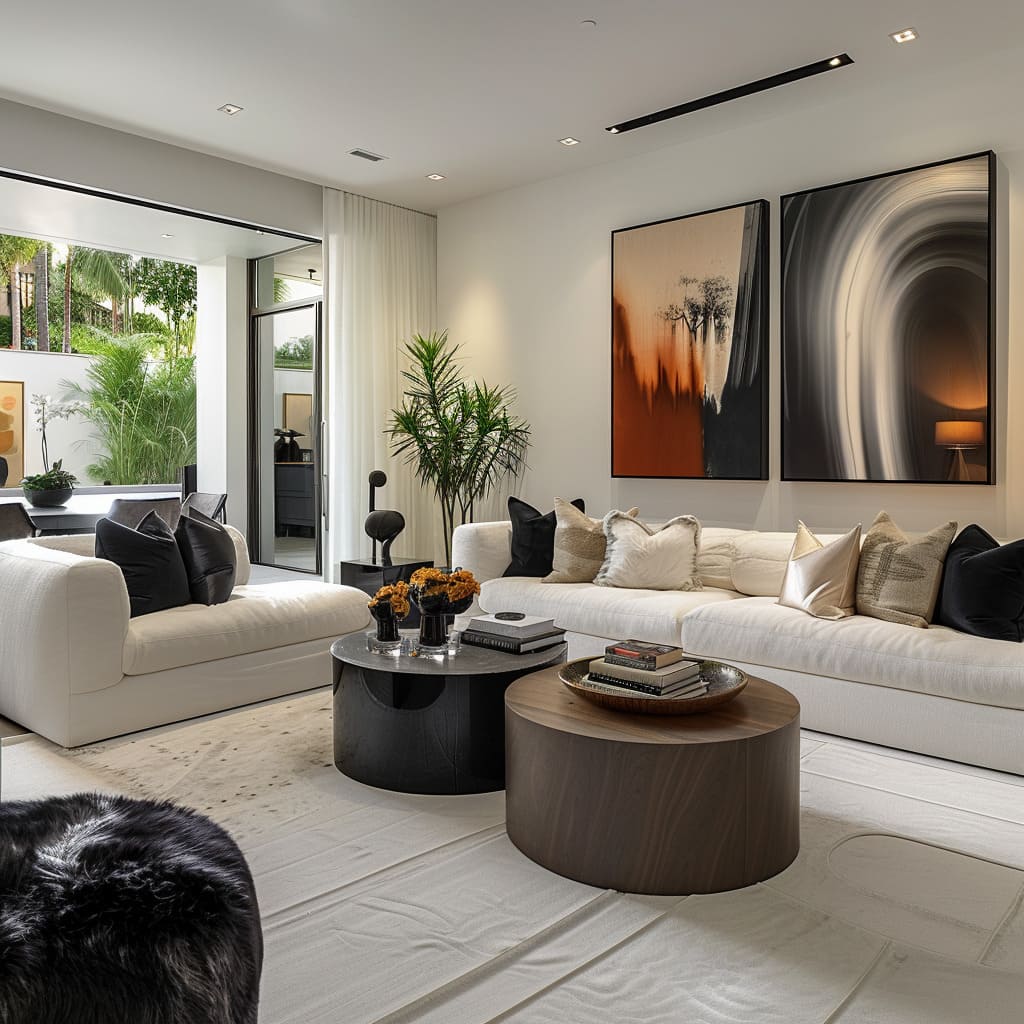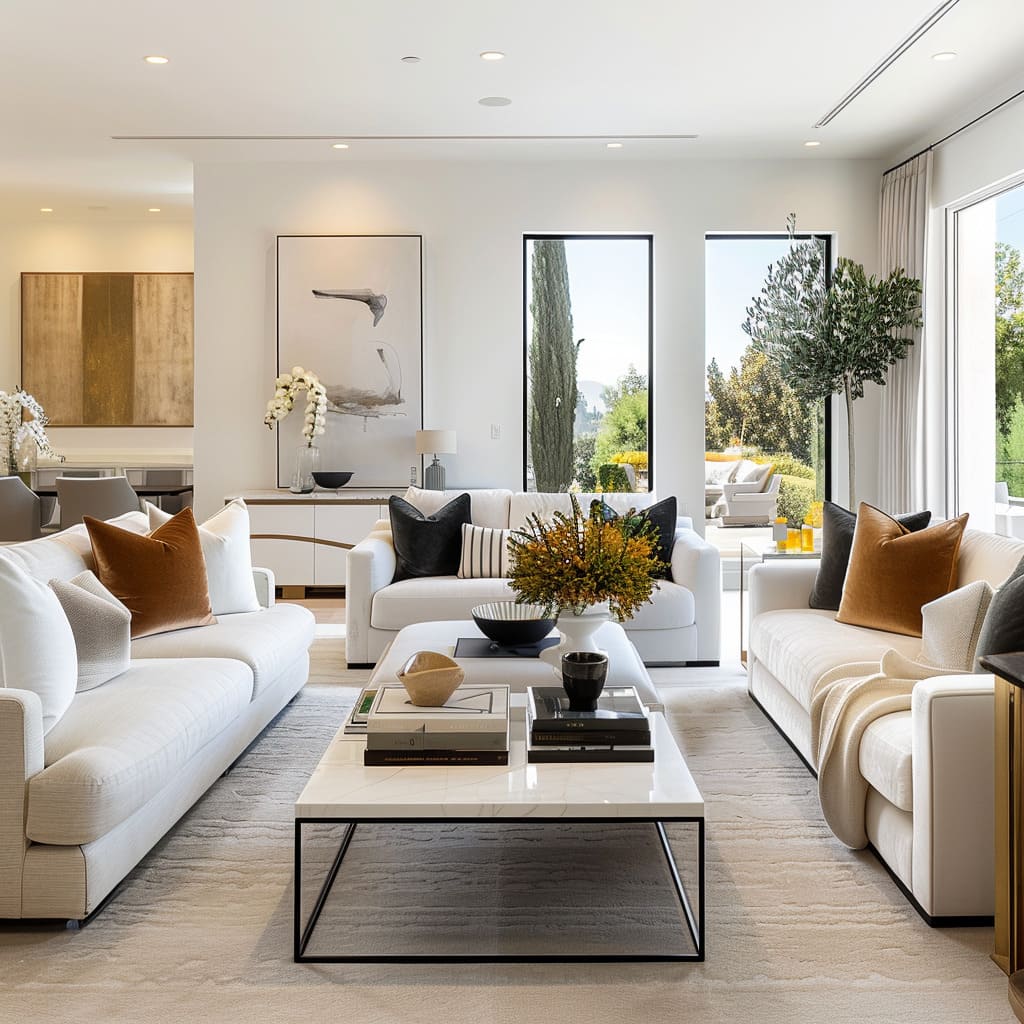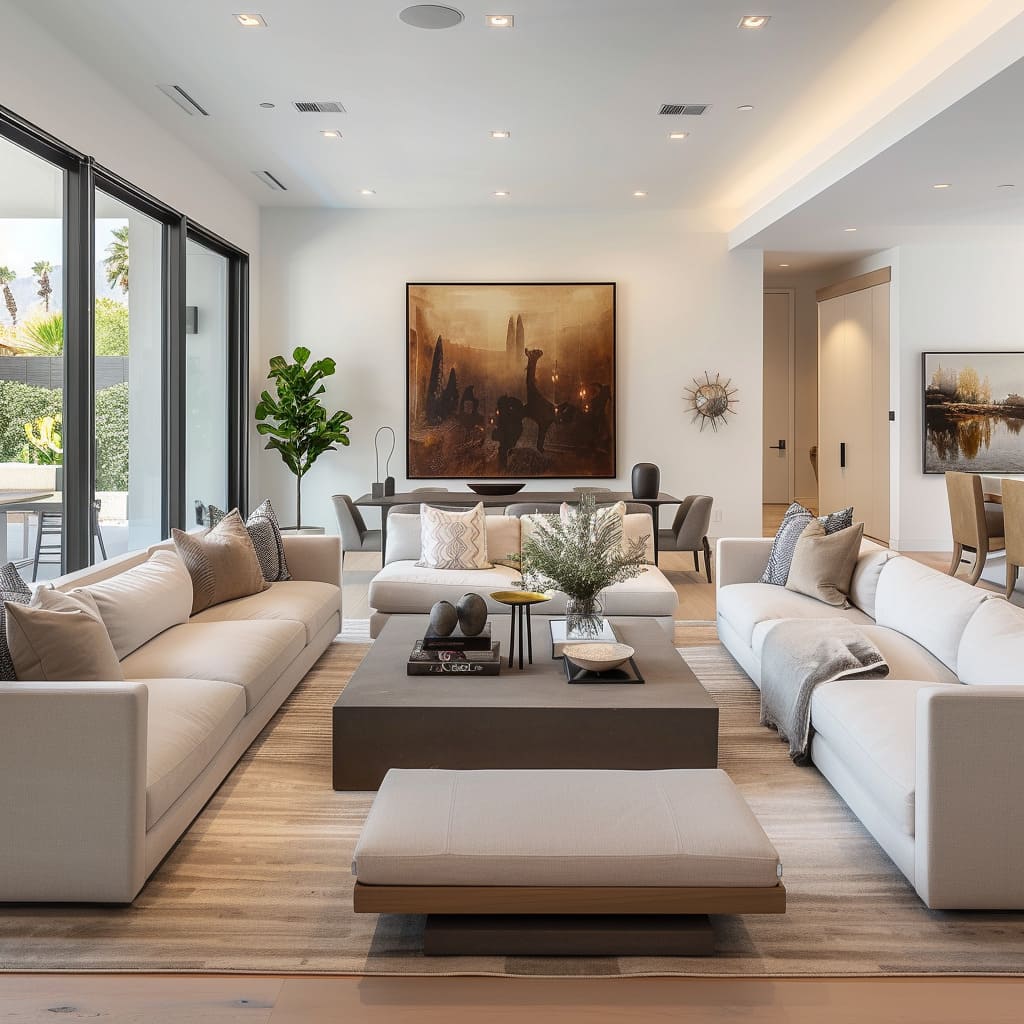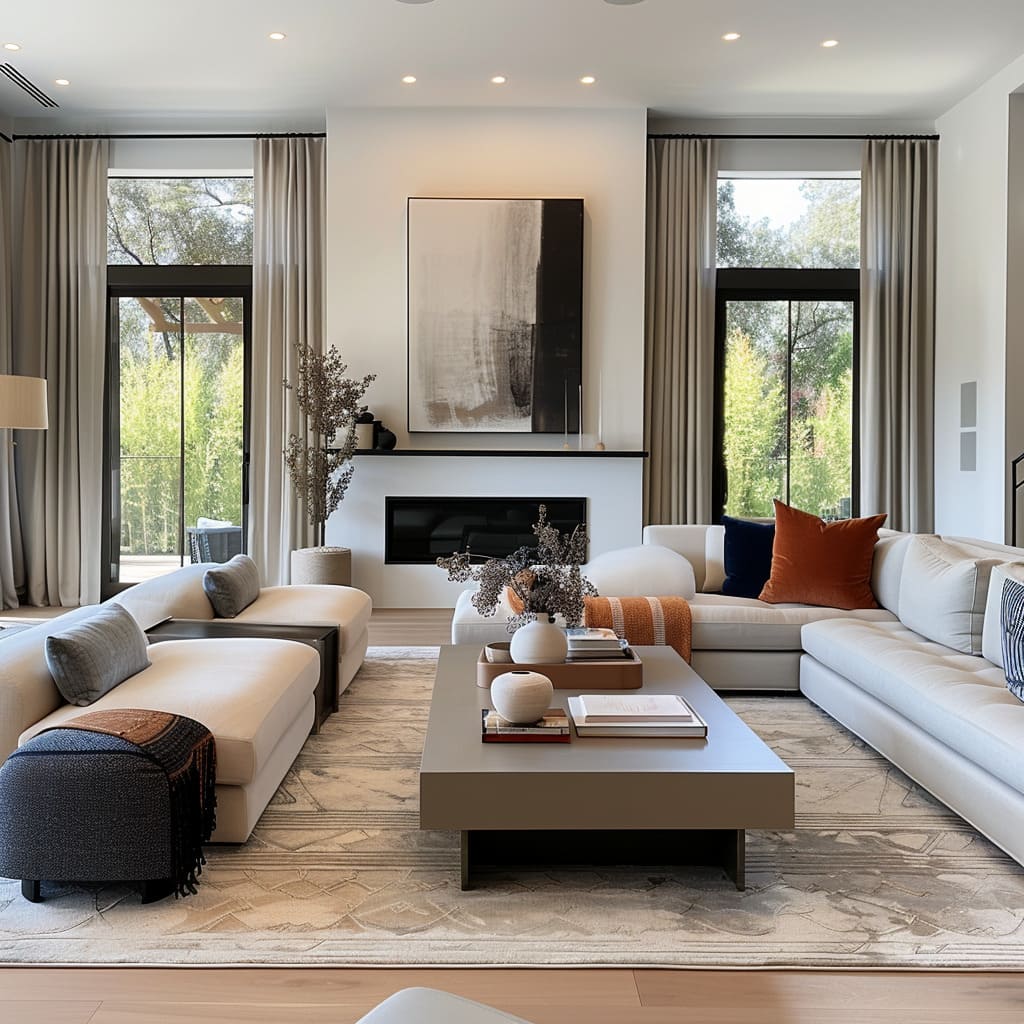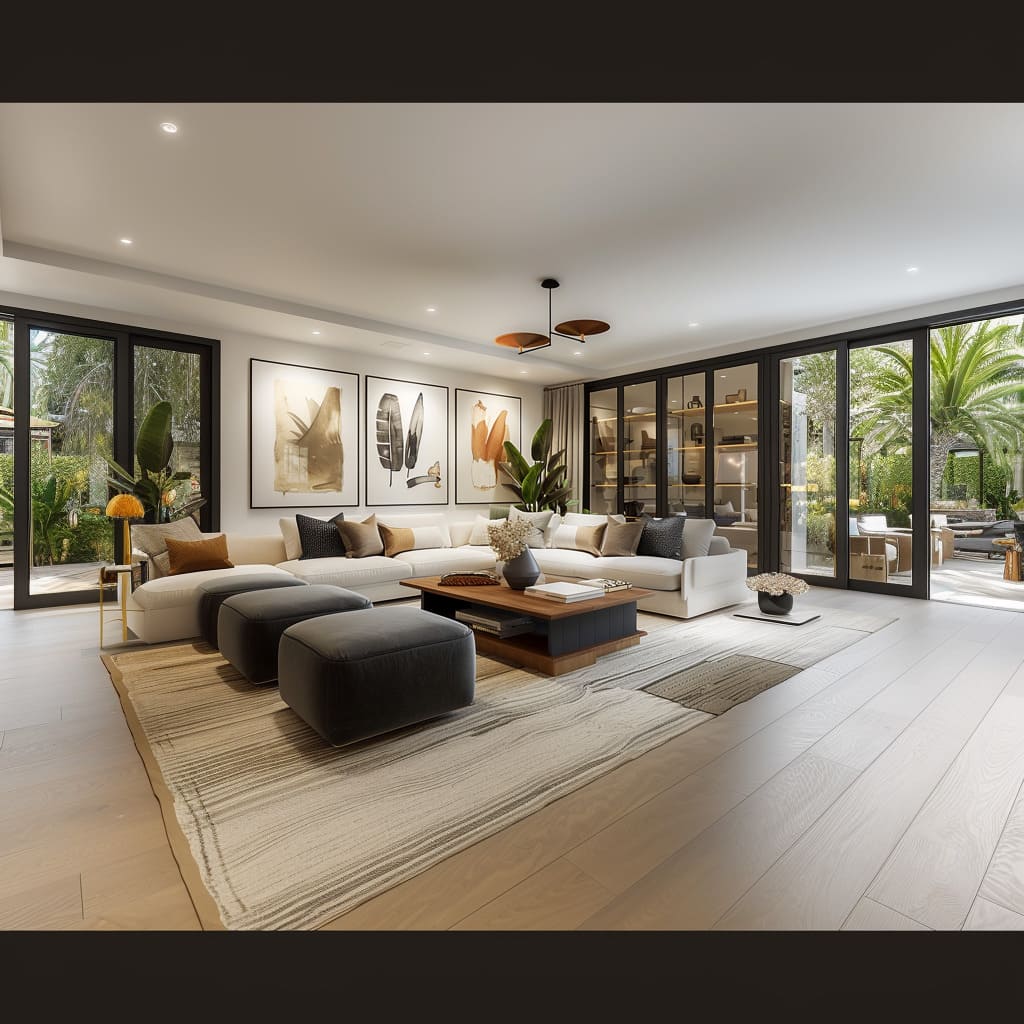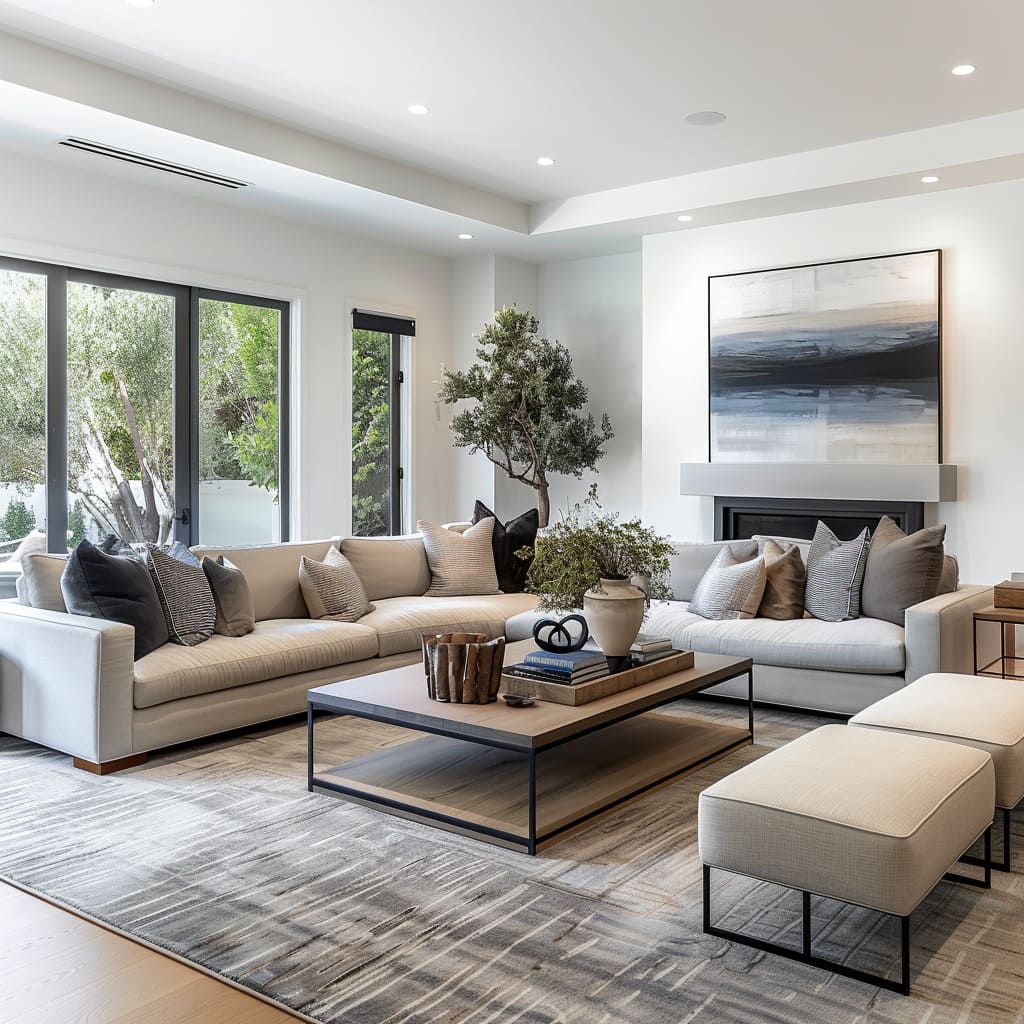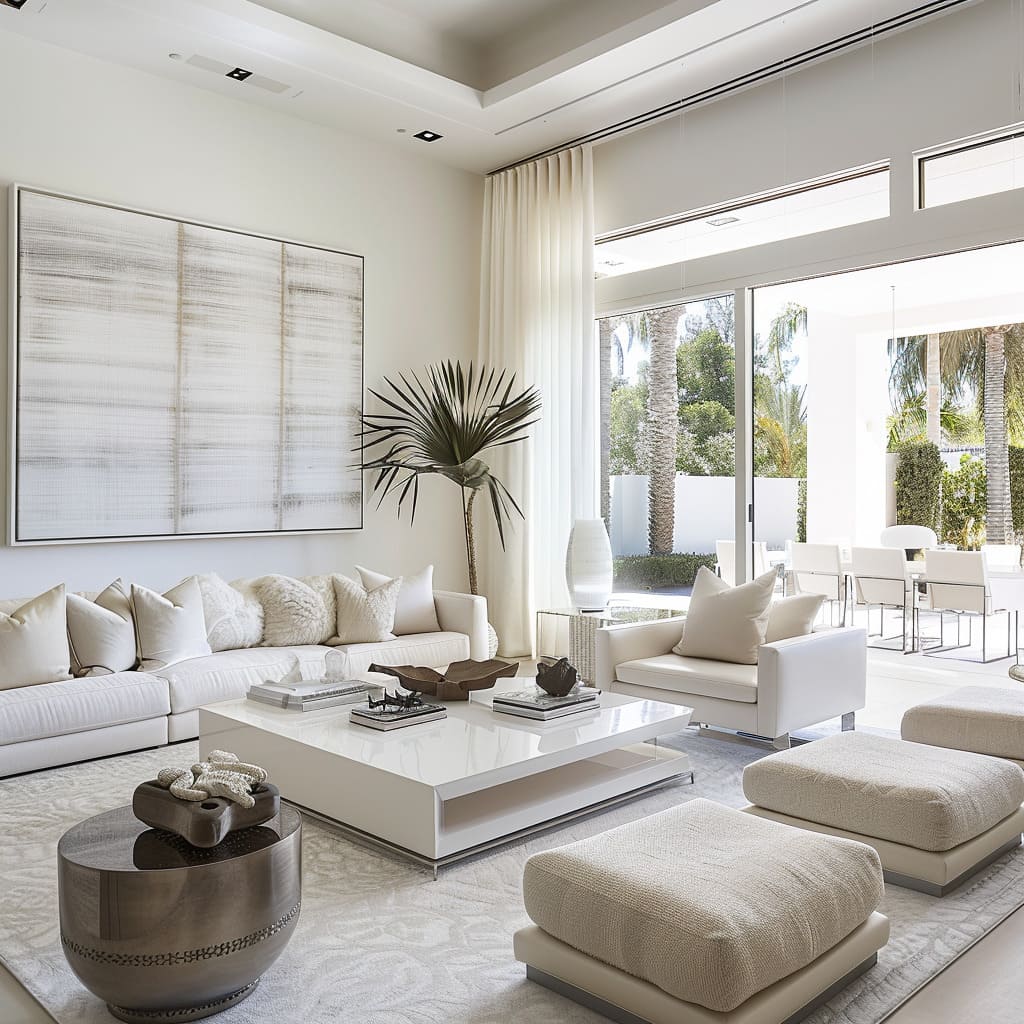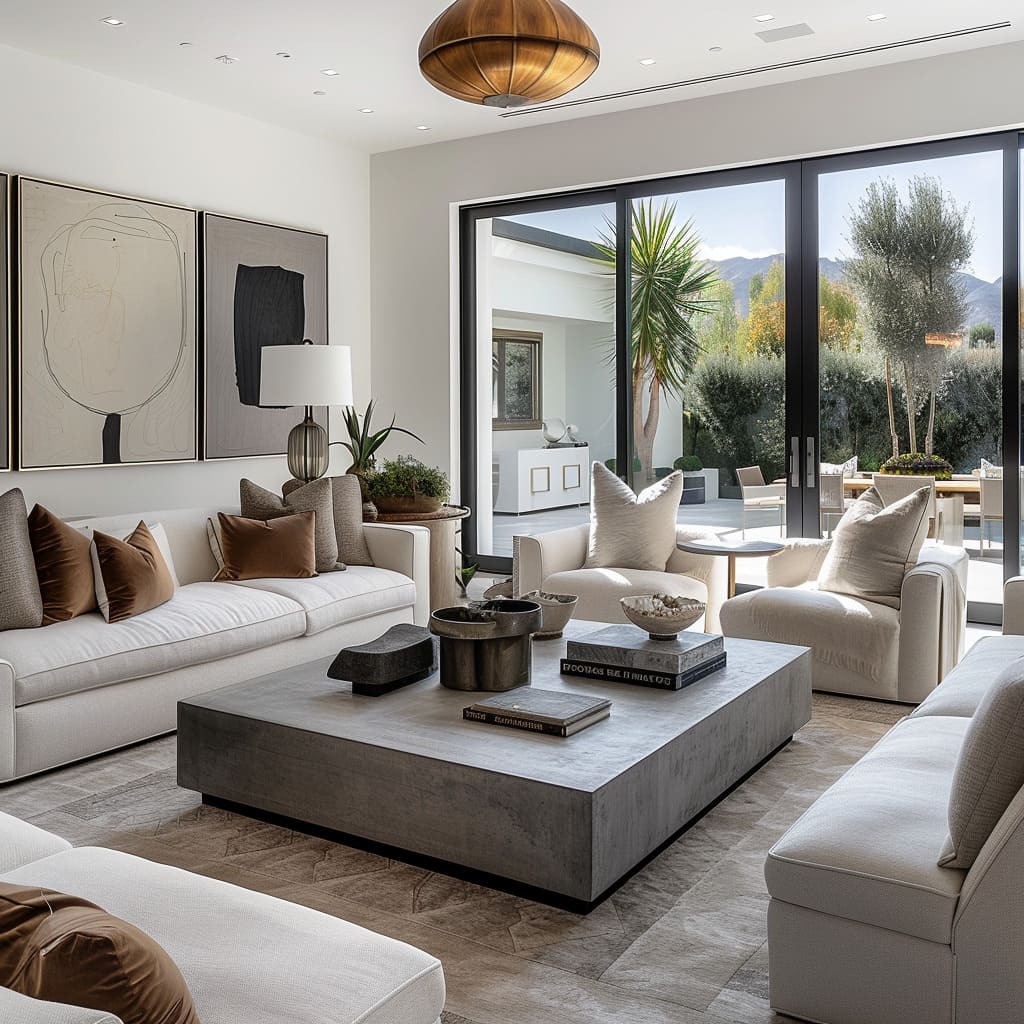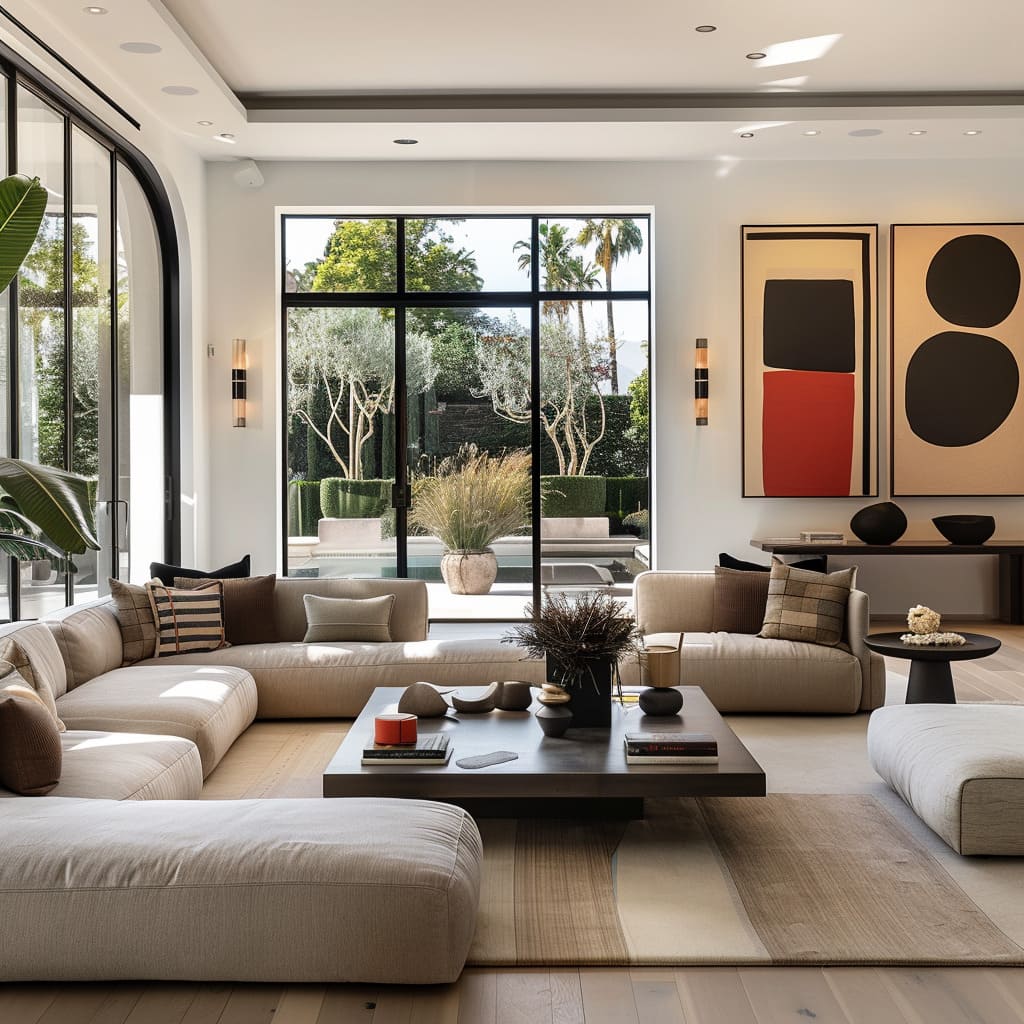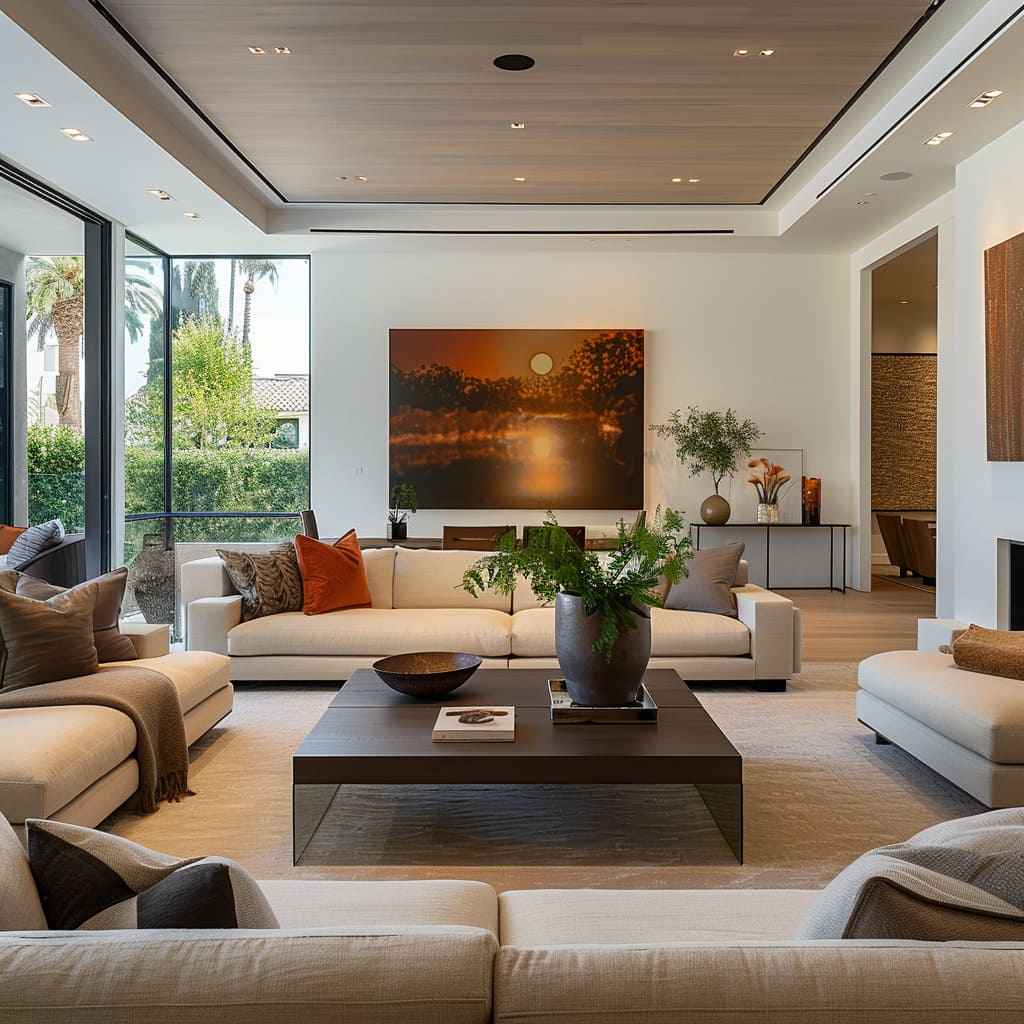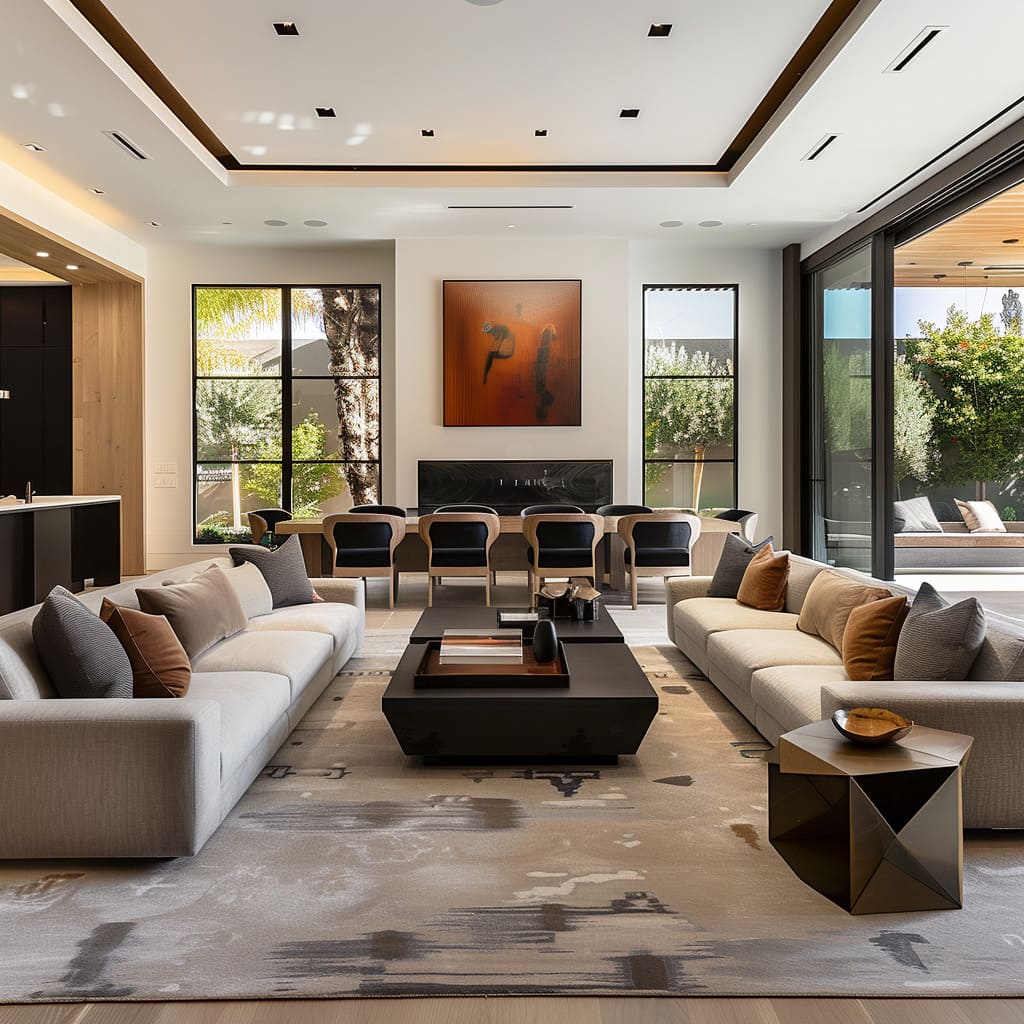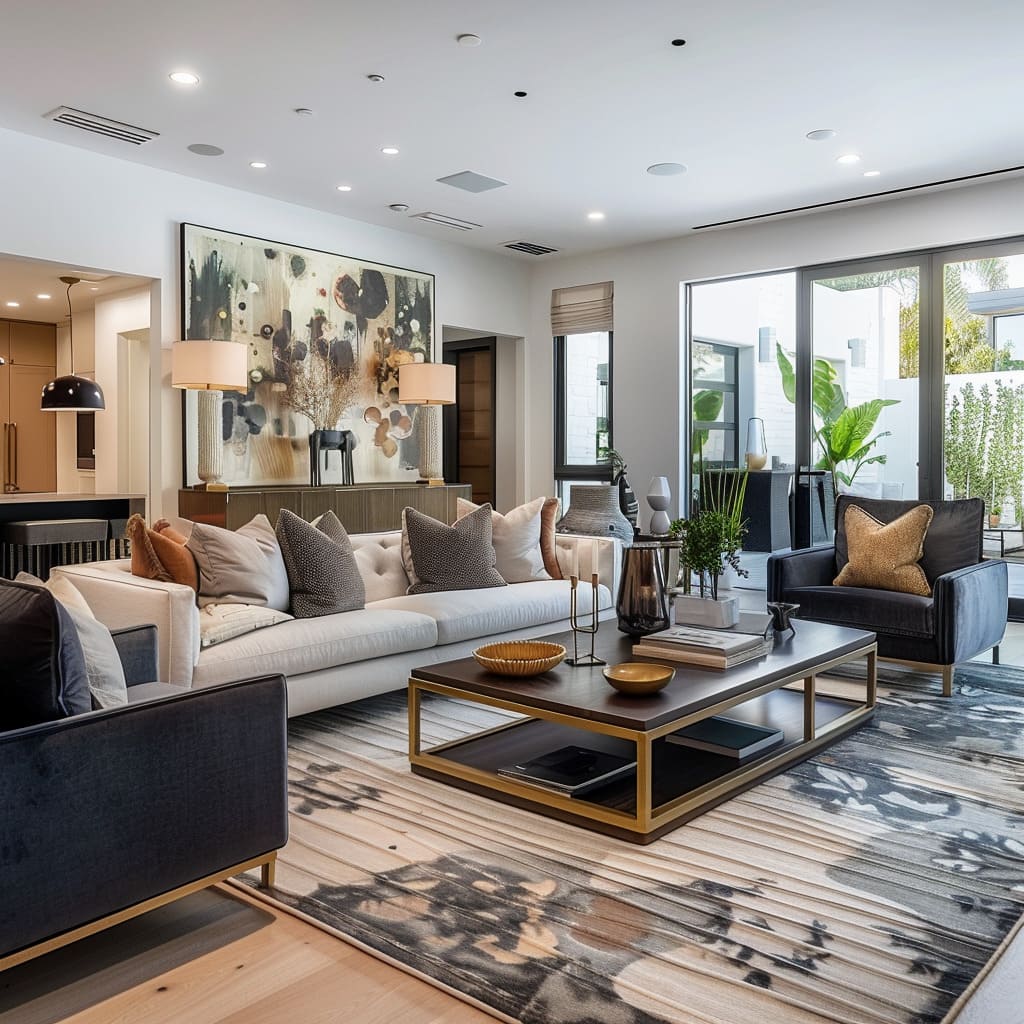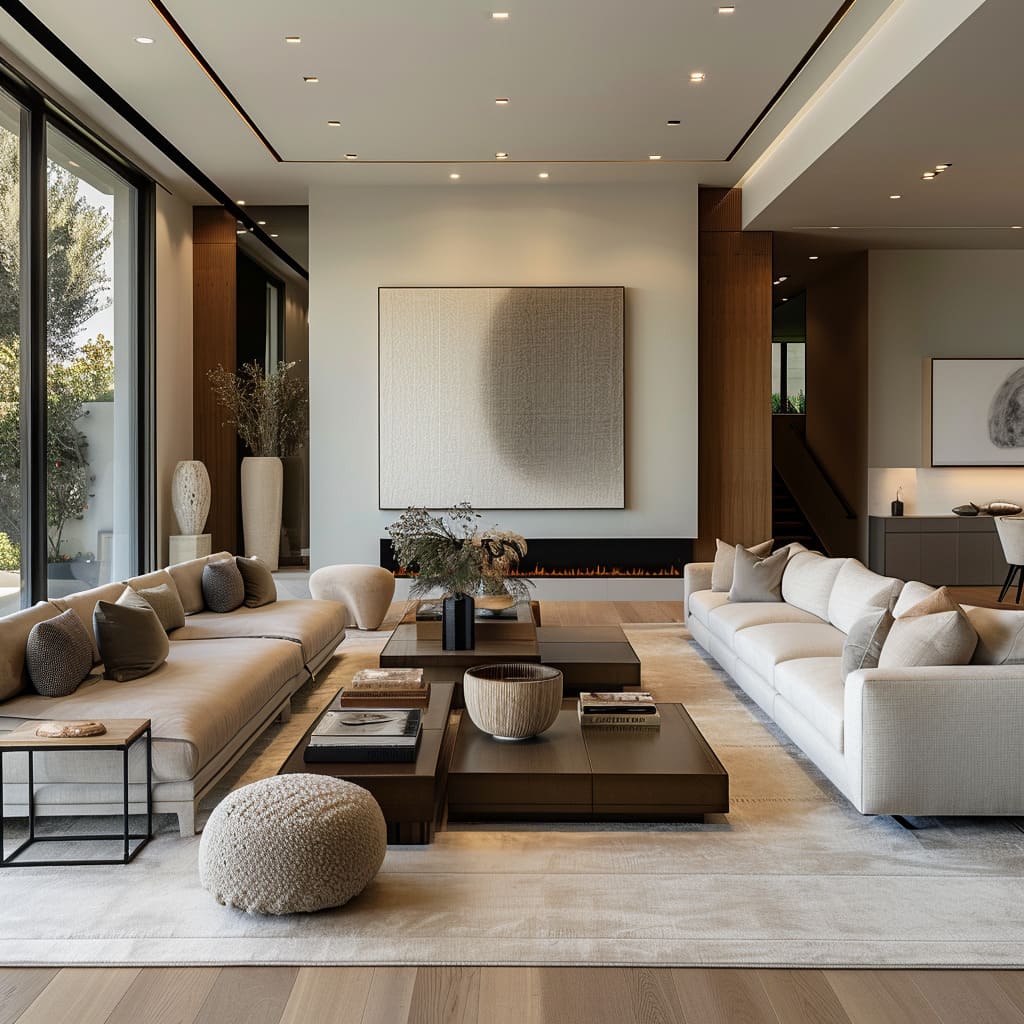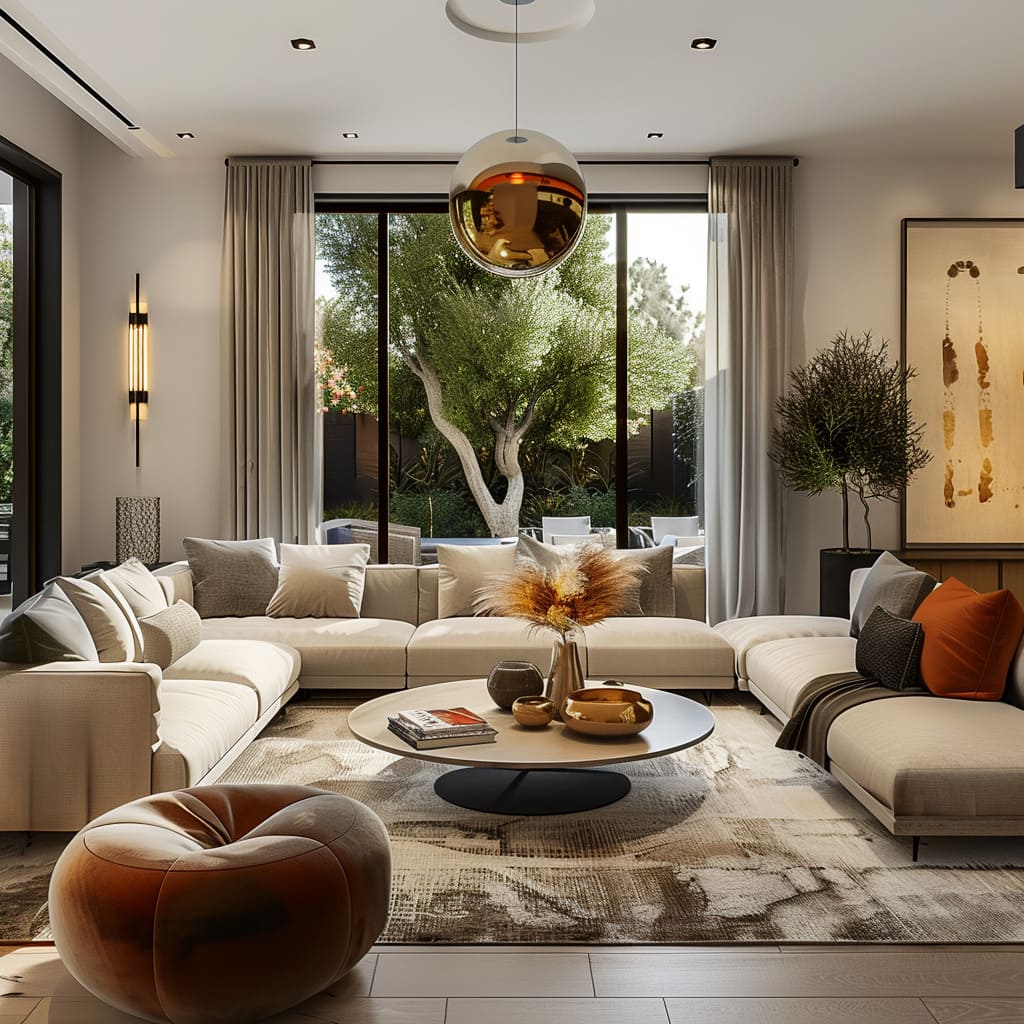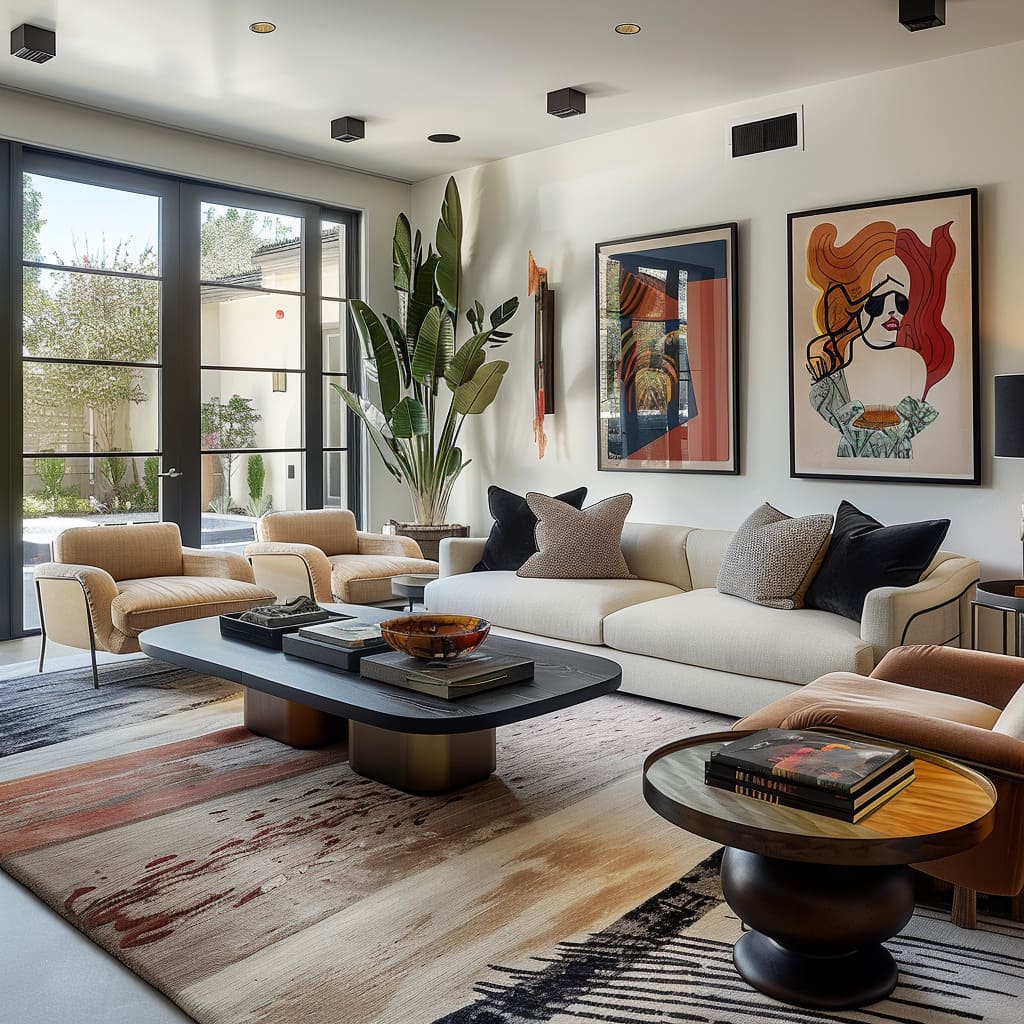In a world where our environments profoundly influence our lives, interior design transcends decoration and enters the realm of art and expression. This article invites readers to a detailed exploration of interior spaces that embody a fusion of form, function, and finesse.
Through a meticulous curation of design elements, we examine how the subtle interplay of architecture, color, furnishings, lighting, and innovative integration constructs not just a living space, but a living experience. This narrative is an ode to the sophistication behind every choice and an insight into how these choices shape our interaction with our most personal spaces.
Architectural Design and Space Management
Maximized Views & Varied Ceiling Heights
Expanding upon the concept of maximized views, the integration of expansive windows not only frames the outside world but also invites a rhythmic change with the day’s natural cycle, influencing the ambiance inside. The thoughtful positioning of these windows complements the geographic location, ensuring that the most striking panoramas are captured.
Meanwhile, varied ceiling heights often rise and fall in harmony with the functional zones they oversee, creating intimate alcoves or lofty, airy spaces where conversation and activity flow effortlessly. These design elements act in concert, defining volumes of space without physical barriers, thereby crafting a living experience that is at once boundless and intimately scaled to human interaction.
Fluidity and Continuity & Use of Glass for Transparency
Delving deeper into fluidity and continuity, the interiors are carefully curated to allow for a visual procession from one area to another, with each transition seamlessly integrated yet distinct. The application of glass achieves more than the illusion of space; it subtly directs movement while maintaining a visual connection that extends beyond the walls.
Floor finishes transition without abrupt borders, subtly demarcating spaces while maintaining a singular narrative throughout the home. Furniture placement is also key, providing natural pathways that guide while allowing for areas of rest and congregation.
This holistic approach ensures that the home functions as an interconnected environment, adaptable to both grand gatherings and quiet moments of solitude.
Uncover the defining characteristics of contemporary home design and see what sets modern architecture apart by reading our insightful article.
Interior Atmosphere and Color
Strategic Use of Color & Accent Walls
The intentional use of color is not merely a matter of aesthetic pleasure but a strategic instrument in shaping the psychological and emotional resonance of an interior. It serves as a backdrop that can either energize a space with vibrant hues or soothe it with soft tones.
The way color is applied — whether it envelops a room, highlights an architectural feature, or is used in accessories — fundamentally alters the perception of space and form. In particular, accent walls act as visual anchors within a room, commanding attention and offering a backdrop against which other elements can stand out.
These walls are often adorned with textures or patterns that break the uniformity, adding depth and interest.
Subtle transitions between shades and tints on adjoining walls create a nuanced interplay that draws the eye and underscores the architectural flow of the space. It’s an approach that avoids stark contrasts, favoring a more understated shift that guides the inhabitant’s mood as they move through the space.
Carefully selected artworks further punctuate the color story, their palettes either complementing or thoughtfully clashing with their surroundings to invoke curiosity and reflection. The choice of color extends to the furniture and decor, where each piece is selected not just for its form but for how its color will contribute to the overall composition of the room.
Cushions, throws, and rugs introduce secondary and tertiary colors that enhance the primary palette. Lighting, too, is critical, with the quality and color of light carefully chosen to bring out the best in the room’s hues at different times of the day.
Beyond the visual, there is a tactile quality to colored surfaces — whether the cool touch of a blue-painted wall or the warm embrace of a sun-kissed ochre — that further heightens the sensory experience of a space. In this rich tapestry, color becomes a silent language that speaks of comfort, belonging, and beauty, inviting those within to linger and engage with the space on a deeper level.
Furnishings and Decor
Modular Furniture Design & Outdoor Furnishing Inside
The strategic selection and placement of furniture are critical to both the functionality and visual rhythm of an interior space. Modular furniture design provides a level of adaptability that is unparalleled, allowing inhabitants to reconfigure their living environment according to the occasion, need, or even whim.
This versatility encourages a living space that is never static but always responding to the nuances of daily life. Bringing elements traditionally found outside into the indoor space creates an unexpected harmony, merging the line between the built environment and the natural world.
These pieces—often characterized by their robust materials and organic shapes—introduce a refreshing rawness that contrasts with and complements the interior architecture. The synergy between such furnishings and the structural elements of a room can offer a surprising and delightful visual cohesion.
Outdoor furnishings within the confines of a home also promote a casual comfort, signaling a place of relaxation and ease. This infusion of outdoor comfort encourages a more informal, serene living experience that embraces the essence of laid-back luxury.
The textures and materials of these pieces, often more rugged and tactile, add a layer of sensory experience that enriches the interaction between person and piece. Further emphasizing comfort, the arrangement of modular pieces is often centered around focal points—such as a fireplace or a stunning view—creating an inviting atmosphere that draws people together.
The ability to move and reposition such furnishings also supports a dynamic lifestyle, adapting to moments of solitude, family gatherings, or social entertainments with fluid grace.
Abstract and Contemporary Art Pieces & Designer Collaboration Pieces
Art plays a transformative role within interior spaces, not only as an aesthetic choice but also as a reflection of the dweller’s tastes and philosophies. Abstract and contemporary art pieces, with their bold strokes and often vivid palettes, introduce an element of surprise and provoke contemplation.
These works act as visual anchors that can command the gaze and add to the narrative of the space. Designer collaboration pieces bring a layer of sophistication and uniqueness that can elevate an ordinary room to an extraordinary showcase of personal style.
These collaborations often result in limited-edition pieces or one-of-a-kind creations that are as much a statement of the inhabitant’s identity as they are furnishings. They embody a convergence of artistic visions, craftsmanship, and design innovation that can define the tone of a room.
The interplay between art and furniture is a delicate balance where each complements the other. Designer furniture often doubles as a work of art, with sculptural forms that can stand alone in their beauty and complexity.
These pieces are positioned not just for their utility but for how they relate to the art on the walls, the colors of the room, and the natural light that bathes them.
In spaces where these unique artworks and furniture pieces reside, there is a palpable sense of creativity and thoughtfulness. It becomes clear that each item has been chosen with consideration and care, contributing to a cohesive collection that tells a story.
The curation of such pieces speaks to a broader vision, where the functional becomes transcendent, and the everyday is elevated to an expression of the aesthetic and cultural values of those who reside within.
Lighting and Detailing
Multi-level Lighting Design & Low-hanging Pendant Lights
The intricacies of lighting design are akin to painting with light; each layer contributes to a harmonious whole. Ceiling recessed spots provide a blanket of illumination, while mid-level wall sconces add a soft glow that highlights the textures and surfaces of the walls.
Lower levels of lighting, including table lamps and floor lamps, cast pools of light that create intimate settings within broader spaces.
Low-hanging pendant lights serve as both illumination and installation, acting as sculptural elements that draw the eye and anchor the space beneath them. The deliberate choice of their design, material, and even the warmth of the bulb can complement the room’s color scheme and influence its atmosphere.
These lighting fixtures can often be found presiding over dining tables or central islands, creating focal points and gathering places. The adaptability of lighting systems, including dimmable and smart home-integrated features, allows the residents to adjust the intensity and even the color of the light to suit the time of day or the desired ambiance.
This versatility is essential in a well-designed space, as it permits the modulation of the setting to cater to various activities, from cooking and reading to entertaining guests. In layered lighting design, shadow plays as important a role as light itself.
The strategic placement of each light source is planned to minimize unwanted shadows and maximize the aesthetic appeal of the space. It’s about crafting a visual experience that is both practical for the inhabitants and visually striking to any observer.
Minimalistic Hardware & Use of Rugs to Define Spaces
The consideration of hardware in an interior space is comparable to selecting jewelry for an outfit; it may be small, but its impact is significant. Minimalistic hardware offers a subtlety that belies its importance, functioning smoothly without clamoring for attention.
The clean lines and understated forms of pulls, knobs, and handles contribute to a modern aesthetic that values simplicity over ornamentation.
Rugs serve a dual purpose, functioning not only as art for the floor but also as definers of space. In an open-plan living area, rugs can create the illusion of rooms within rooms, offering visual cues as to the purpose of each area without the need for walls.
They can anchor furniture groupings, denote a change in function, or even alter the perceived scale of a room. The texture and material of a rug are as important as its size and placement.
A plush, thick rug can invite bare feet and casual lounging, while a flatweave can suggest more utilitarian spaces. The pattern and color of rugs are also used to echo or contrast with other textiles in the space, tying together a color scheme or adding an unexpected pop of visual interest.
Beyond their visual appeal, rugs can also affect the acoustics of a room, absorbing sound and reducing echoes in spaces with hard surfaces. This acoustic consideration contributes to a room’s sense of comfort and tranquility.
The strategic combination of minimalist hardware and well-chosen rugs can drastically elevate the sophistication and functionality of an interior. It’s a testament to how minor elements, when selected with intention and care, can weave together to create a space that is both visually cohesive and richly textured in experience.
Integration and Innovation
Innovative Material Use & Fusion of Styles
The intersection of diverse materials within a space can lead to a rich tapestry of textures and finishes that play off one another, enhancing the sensory experience of the environment. These materials are not chosen at random; their selection is precise, calculated to bring out an interplay of matte and shine, rough and smooth, transparent and opaque.
From the sleek coolness of metal accents to the warm, organic feel of wood grains, each material is a deliberate choice that contributes to a layered narrative of the space.
The fusion of styles from different eras and movements in design history can produce a space that is both a nod to tradition and a stride towards modernity. Vintage-inspired pieces alongside contemporary forms create a dialogue between past and present, allowing the space to be timeless yet rooted.
This conversation between different periods can also be seen in the juxtaposition of classical motifs with modern geometric patterns, offering a visual and historical depth to the living space. Innovations are not limited to aesthetics; they include the functionality of materials.
Surfaces in high-traffic areas may be treated with advanced finishes for durability, while maintaining a luxurious appearance. Similarly, innovations in fabric technology contribute to upholstery that is not only beautiful but also resilient to the stresses of everyday use.
The integration of different styles is conducted with a sensitivity to proportion and scale. A grandiose vintage table may serve as the heart of a room, while sleek, modern chairs encircle it, their slim profiles providing visual relief.
This harmony in proportions ensures that each piece, while distinct in style, feels that it belongs.
Integrated Art Displays & Contemporary Fireplaces
The manner in which art is displayed can profoundly influence the character of a space. Built-in shelving and discreet lighting are designed to showcase art pieces to their best advantage, turning personal collections into integral elements of the home’s design.
Art is not an afterthought; its placement and presentation are considered from the outset, with architectural elements often designed to accommodate specific pieces.
Contemporary fireplaces, with their clean lines and absence of traditional mantles, become sleek focal points that offer warmth without visual clutter. The material selection for these fireplaces can vary from smooth, honed stone to industrial metal, each contributing a different texture and color to the space.
The fire’s glow is framed in a way that accentuates the design, offering both physical warmth and a warm aesthetic. The design of the contemporary fireplace often reflects the overall design sensibility of the space, reinforcing the aesthetic through consistency in materials and form.
Whether it is the centerpiece of a room or a subtle addition, the fireplace is integrated in such a way that it feels organically linked to the rest of the space.
Innovative display technologies also allow art to be experienced in new ways. Digital frames can display a rotating collection of works, ensuring the visual experience within the home is dynamic and ever-changing.
This blend of technology and art underscores a modern approach to interior design that values both form and function. The placement of art and the design of fireplaces consider not just the immediate surroundings but also how they interact with the natural light entering the space.
The interplay of light and shadow throughout the day can transform the appearance and ambiance of these features, making them living parts of the interior design that change and evolve with the passing hours.
Functionality and Convenience
Discrete Technology & Integrated Art Displays
The integration of technology into the fabric of a home goes beyond mere functionality; it’s about enhancing the living experience while maintaining the integrity of the design. Speakers are embedded into walls, televisions are cleverly disguised as mirrors or artworks when not in use, and lighting and climate controls become almost invisibly integrated, accessible through discreet panels or smart devices.
These technological inclusions are designed to be intuitive, responding to the inhabitants’ patterns and preferences, creating environments that adjust to their needs without effort. The harmony between the advanced systems and the design aesthetics is so seamless that one might not immediately perceive the level of sophistication in play.
Art displays in these spaces do more than fill a visual void; they reflect the passions and tastes of the residents. These displays are integrated with such finesse that they seem intrinsic to the walls themselves.
Lighting plays a pivotal role here, with dedicated fixtures that highlight textures and colors, ensuring that each piece of art is experienced in the best possible context. The calibration of these display lights is carefully considered to ensure that they contribute to the ambiance of the room, complementing the natural light during the day and providing a soft luminescence at night.
This thoughtful integration supports the dual purpose of art in these spaces: as a touchstone of personal identity and as a foundational element of the interior design.
Incorporation of Greenery & Fusion of Styles
Plants within a living space do more than fill corners and decorate surfaces; they become living sculptures that contribute to a home’s dynamic. Larger plants can act as natural dividers, subtly segmenting open-plan spaces without the need for walls, while smaller greenery brings a sense of life and growth to shelves and tables.
The inclusion of greenery also contributes to the air quality and brings a level of biophilic design into the home, fostering a connection with nature that can enhance well-being.
The selection of plant species is as much a design decision as it is a horticultural one, with textures, growth habits, and container choices all contributing to the aesthetic. Plants are matched to their locations not just for their light requirements but for how they complement the space—tall, architectural plants might accentuate the height of ceilings, while trailing plants can soften the lines of a shelving unit.
This living aspect of design works in concert with a considered blend of styles that reflect a storied approach to decor. Pieces that tell a story—whether through their historic provenance, unique craftsmanship, or the way they’ve been repurposed—give a room a sense of depth and narrative.
A well-traveled trunk might serve as a coffee table, its scars and patina adding character to a contemporary sofa set.
The juxtaposition of old and new, handcrafted and manufactured, creates a dialogue within the space that is both visually stimulating and reflective of the complex layers of history and design. These elements interact in a space not as a collection of objects but as a symphony of styles, each contributing its voice to the harmonious whole.
In these thoughtfully designed spaces, each choice—from the discreet integration of technology to the lush presence of greenery, from the art that adorns the walls to the furniture that tells a story—reflects a philosophy of living that values beauty, comfort, and functionality.
In conclusion, the art of interior design is found in the delicate balance of creating spaces that are both aesthetically pleasing and deeply functional. It’s a confluence of various elements – the majesty of nature brought indoors through strategic views, the personalization of space with art and color, the intelligent integration of technology, and the infusion of life with greenery – all coming together to create environments that are not just to be lived in, but to be lived through.
As we close this chapter on the detailed characteristics of contemporary interior design, we acknowledge that these spaces are more than the sum of their parts; they are the canvas of our lives, echoing our stories, and resonating with the cadence of our day-to-day existence.


